Spiritual Life offers service opportunities
ANYSSA GONZALEZ ASST. NEWS EDITOR
Spiritial Life’s (SL) serve season has begun and students are getting ready to sign up as they step into new growth opportunities. SL Serve Days offer a chance for students who are interested in serving local communities as well as the global community during the GenSend summer. The GenSend summer offers students the opportunity to join God’s story by traveling to cities in North America.
Morgan Caver, director of Compassion Ministries, explains the opportunities offered for students who sign up.
“SL Serve Days are important because they are an opportunity for students to serve the community together,” Caver said. “We want students to learn and engage the needs of the community. We can all grow in our understanding of how to help those around us and this is an opportunity to grow in that way. We believe this is a part of developing in Christ-like character.”
Caver said that SL Serve Days consist of partnering with local organizations so that students and staff can sign up to serve through these organizations throughout the Riverside area. Serve Days take place on Saturdays from 8 a.m. to 1 p.m. and include traveling to local projects and enjoying lunch with fellow students afterward.
Gabby Burrow, senior intercultural studies major and Spiritual Life intern, described how students are provided a bonding experience while
serving.
“Serve Days are a great way to engage the local community through service opportunities while also providing a way for students at CBU to bond over a common cause,” Burrow said. “I highly recommend signing up for one of the serve days and giving up your Saturday morning to service.”

Burrow is participating in the Keep Riverside Clean and Beautiful project through which students can help keep Riverside clean.
“I will be participating in the Keep Riverside Clean and Beautiful Project 2, and we will be taking a group of students out into the surrounding areas of CBU to engage the community by picking up and disposing (of) trash,” Burrow said.
As Burrow explained her project, she included the preparation that each project requires for Serve Days.
“A lot of prep went into this event,” Burrow said. “Each project has their own unique requirements in terms of preparation. Cleaning supplies, safety vests and waivers had to be acquired for our Keep Riverside Clean and Beautiful project.”
While SL continues to promote their serve days, it allows students to make an impact for the community.
Jackson Peters, junior accounting major, explained how SL Serve Day events are a great way to serve.
“Spiritual Life does an amazing job integrating Christian stewardship for
Disney teases remake of ‘The Little Mermaid,’ its newest live-action film
BY GABI RIGGINS ASST. A&E EDITOR
After four years of antici pation, “The Little Mermaid” live-action teaser trailer release has sent the media into a frenzy with what to expect for the new movie set to come out on May 26.
The remake was announced by Disney in July 2019 when they cast actress and singer Halle Bailey as Ariel.
This musically inclined film has left fans curious about “The Little Mermaid” and its new soundtrack.
The teaser shows Bailey swimming through her cave of treasures and thing-a-ma-bobs, followed by Flounder as she sings the classic tune “Part of Your World” from the original film in 1989. So, what does this mean for the music?
According to The Insider
Magazine, “Hamilton” cre ator Lin-Manuel Miranda and EGOT winner Alan Menken will be the music composers of the new soundtrack. Miranda told Variety that the film would have three or four original songs that will not replace popular classics and will be inspired by Ariel’s time on land.
“She experiences a lot of firsts, as someone with legs for the first time,” Miranda said. “We got to lean into all of that musically.”
Mackenzie Hansma, soph omore worship arts and minis try major, said she is curious to see how Miranda’s style blends with Disney’s usual brand.
“Lin-Manuel Miranda has a specific style with all his Broad way songs, a lot of overlapping of different melodies,” Hansma said. “So I am interested to see how that is going to come into play with Disney because Dis
Campus safety
In light of recent crime on campus, Safety Services shares their steps toward student safety.
Pg. 2
ney has a simpler style than Lin does.”
Hansma is looking forward to seeing the fresh take Bailey brings to her role in “The Little Mermaid.”
“I’m excited because (she) is so vocally talented, and it does bring a different kind of singing to Disney because they add all the riffs and the runs,” Hansma said. “I have high hopes.”
“The Little Mermaid” is not the first classic remade into a live-action film by Disney.
In fact, remaking classics has become a common theme for Disney. The company has re made multiple films from their past era, from “Cinderella” in 2015 to “Pinocchio,” which was just released Sept. 8.
There are many different components to making a new
Learning styles —
Psychology professor explains why preferred learning styles are not scientifically supported.
Lifestyle, Pg. 7
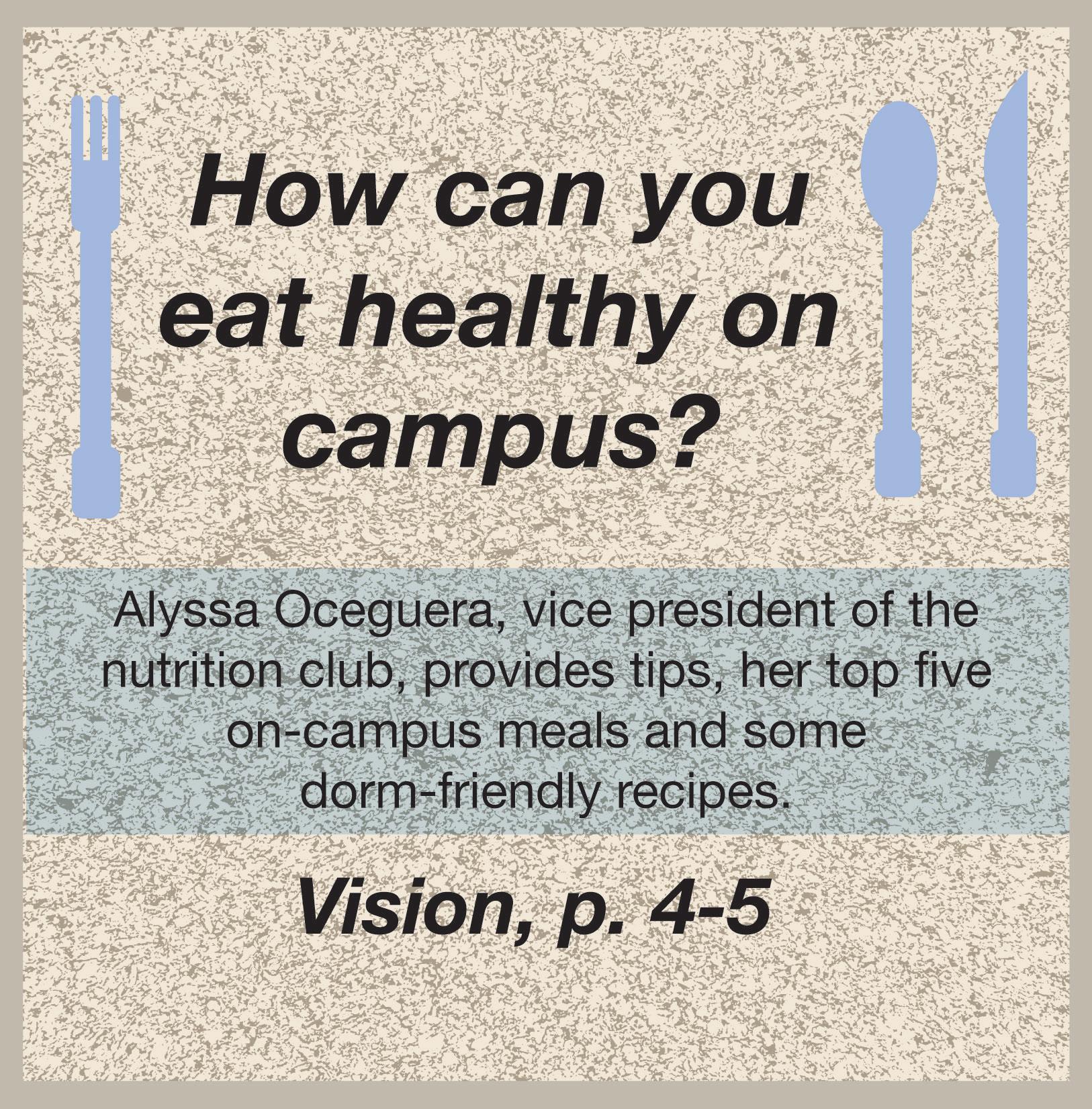
Science and faith —
Professors and students answer the age-old question of whether science is compatible with faith.
B&T, Pg. 11
Courtesy of Spiritual Life
Students participated in activities on Sept. 24 that served the local community.
SEE SERVE DAYS | PAGE 2 SEE LIVE ACTION | PAGE 12
News,
@cbulancermedia cbubanner.com ISSUE 2VOLUME 70 SEPTEMBER 30, 2022
Lancer
- Yeager Center (Campus Bridge Drive near Welcome Pavilion)
- Health Science Campus (Rear parking lot)
- Adams Business Park (Classroom B-14)
- Architecture Building (Front)
Lancer
Serve Days
Asst. Design Editors
Charissa Graves Zerenity Lopez
Business & Tech Editor



 Asst. Web Administrator Anyssa Gonzalez
Asst. Web Administrator Anyssa Gonzalez
from Page 1
students to step into growth by serving locally,” Peters said. “The opportunities that SL provides make a di erence in our communities while students can get an experience to make a di erence.”
Other service projects include the Inland Vineyard Church project, where students help with a food pantry. At Olive Crest and Mead Valley Community Center, students assist with o ce organization and event prep, and at California Baptist University Facilities and The Grove Community Church, students work on outdoor projects. Lastly, at Path of Life Ministries

The Banner retains the right to edit your letter upon publication based on grammar and word count. Send letters to Emily McGinn, editor-in-chief of The Banner at BannerEditor@ calbaptist.edu.
If you have a story idea for The Banner, please let us know. If a business would like to advertise in the The Banner, please contact Emily McGinn at emilyanne.mcginn@calbaptist.edu.
Thanks for reading!
Lancer
- Yeager Center (Campus Bridge Drive near Welcome Pavilion)
- Riverside Airport (Front driveway)
- Events Center
- East Parking Structure -Lancer Arms (On Lancer Lane)

Safety Services updates HSC security measures
ANYSSA GONZALEZ ASST. NEWS EDITOR
This semester, Safety Services is implementing changes after multiple alerts regarding suspicious behavior across the campus.
These alerts occurred early in the semester, leaving some students concerned.
“I am honestly more afraid than I was last school year,” said Veronica Salcedo, graduate education major. “I especially am more cautious around school and being more aware of my surroundings.”
Incidents on the Health Science Campus (HSC) and in the Village have involved trespassers who gained access to campus. In the incidents on the HSC, female students have reported a male subject who was caught recording at the top of the bathroom stalls.

In the Village apartment assault, a male student reported that he heard a knock that would eventually lead to a male subject entering
the apartment and physically assaulting the student.
John Freese, director of Safety Services, said that the school prioritizes safety.
“CBU is a unique campus that is not open to the public,” Freese said. “Everyone who enters must have a legitimate reason for being here.”
Freese said that o cers patrol the campus 24 hours a day to make sure that everyone who is on campus is supposed to be there.
“Our intention is to be transparent with our community about crime that occurs on or near our campus so we can all be aware and take steps to protect each other,” Freese said.
In light of the incidents, Freese said Safety Services is taking steps to ensure safety.
“We provide highvisibility patrols and we are leveraging new social media e orts to help make students aware of our services,” Freese said. “CBU is located in a busy metropolitan city. Crime
that occurs near campus is a concern for my team and we closely monitor incidents in our area.”
Since the most recent incident, Safety Services has also taken steps to secure the HSC, such as requiring card swipes to enter the bathrooms on the HSC and increasing the presence of safety personnel on the HSC.
Safety Services also encourages students to employ the “see something, say something” method by reporting any suspicious activity they witness.
Freese said he believes that CBU can work together to be successful in preventing crime by being a community partner and quickly reporting issues of concern.
“Safety Services is committed to messaging students with our Safety Services alert emails to educate about crime on or near campus,” Freese said. “Those emails will include safety tips to help
students take steps to protect themselves. We use emergency text alerts to notify students of immediate safety concerns on or near campus and those alerts include directions on how to stay safe.”
Emmanuel Elias, freshman biology major, is glad Safety Services has responded to the incidents, but would like to see more.
“I feel good at the fact that they keep us updated with safety alerts when something serious occurs,” Elias said.
“However, a lot more safety security measurements can be taken to ensure protection and prevention.”
As Safety Services works to ensure safety for students, sta and faculty, Freese said they want to remind CBU of their strong partnership with the Riverside Police Department, which led to the successful identification and arrest of the suspects associated with the recent crimes on campus.
2022 California Propositions
Prop 1
Abortion rights in the
Prop 28
Guarantee funding for arts and music education
California would have to dedicate at least 1% of funding for public schools and community colleges to music and arts education. This 1% would be about $1 billion each year.
Schools with more low-income
Prop 26
Legalizing sports betting at tribal casinos
This
Prop 31
Uphold
Prop 27
Allow online sports betting
This proposition would allow
and
companies to
Prop 29
Impose new rules on dialysis clinics
Kidney dialysis clinics would need to have at least one physician, nurse practitioner or physician assistant with six months of related experience on site or via telehealth.
Prop 30
Tax millionaires for electric vehicle programs
Californians making more than $2 million each year would receive a 1.75% personal income tax increase to fund climate programs.
A “yes” vote would uphold a 2020 law in place to prevent the sale of some flavored tobacco products. A “no” vote would overturn the law and allow for the sale of these products.
Jasmine Severi
Asst. Lifestyle Editors
Valerie La Ponza Olivia Lenning
on
tobacco products
Emily McGinn | Banner
Emily McGinn | Banner
Courtesy of Spiritual Life
Students
2 September 30, 2022 · Volume 70 · Issue 2 NEWS THE BANNER sta f f Editor-in-Chief Emily McGinn Managing Editor Alexza Bahnmiller Web Administrator Casey Maldonado Photo Editor Charissa Graves Design Editor Emily McGinn News Editor Emily McGinn Asst. News Editor Anyssa Gonzalez Arts & Entertainment Editor Zerenity Lopez Asst. A&E Editor Gabi Riggins Asst. B&T Editor Kristie Wiseman Asst. Director of Student Publications Abigail Wolf Director of Student Publications Sonya Singh Lifestyle Editor Alexza Bahnmiller Sports Editor Emily McGinn Asst. Sports Editor Hannah Gordon Social Media Director Jalen Turner Advertising Manager Roman Zozulia Cartoonist Carly Brunner Distribution Manager Kristie Wiseman Editor-in-Chief Emily McGinn Photo and Video Editor Charissa Graves PRINT ONLINE F l u s ! Keep up with CBU news and events @CBULancerMedia THE BANNER Ab t The Banner newspaper is an award winning, bi weekly campus publication that publishes 10 issues a year at California Baptist University The newsroom is located in the James Building in Room 060 and can be reached at 951-343-4787. The Banner, a student-run newspaper, serves the CBU community with accurate, timely and factual reporting on significant aspects of university life, Riverside life and subjects of interest or concern to its readers others in the university are encouraged to react to published material or to comment on matters of conern.
W e w a n t y r h e l p ! Wr ite, take photos or design w ith us. Email us at BannerEditor@calbaptist edu for more information.
For more information, visit calmatters.org
state constitution This proposition, if passed, would amend the California Constitution to ensure the right to abortion and the right to use or refuse contraceptives. This right is already part of state law.
ban
flavored
proposition would allow tribal casinos and horse race tracks to allow in-person sports betting.
students would receive more funding.
tribes
gaming
provide mobile and online sports betting.
Continued
SHUTTLE STOPS
Express South Shuttle
Express Shuttle Mon.-Thurs. 8 a.m. - 7 p.m.
Runs both loops above
Express North Shuttle
Fri. 8 a.m. - 5 p.m.Shuttles do not run: 11-11:15 a.m. 1-2 p.m. 4:15-4:30 p.m.
smile at a SL Serve Day event in the local community on Sept. 24.
University o cial shares future of campus parking
BY EMILY MCGINN EDITOR-IN-CHIEF
With the return to fully in-person activities, including Chapel, to campus this semester, one issue has become a concern for many California Baptist University students: the parking, or lack thereof. This semester, students have had to circle parking lots searching for spots and some have missed classes or activities as they search for a place to park.
“Parking this year on campus has been really di cult since there are more students this year,” Victoria Coria, sophomore interior design major.
“I live at Magnolia Crossing and it takes me maybe 20 minutes to find decent parking. I have to wake up around one hour early before my classes to make it to campus and get to class on time.”
This is an especially frustrating issue for commuters.
“This semester, I have had the worst time finding parking while being a commuter,” said Taylor Farr, senior communication sciences and disorders major.
“On the Health Science Campus, I have had to search the parking lot twice before I could find a spot. I have been late to my class because I have not been able to find a parking spot.”
Christian Dinco, assistant director of Safety Services, said the school is encountering parking scarcity because the student enrollment is always growing. Although the East Parking Structure has helped the school cope with overflow, students are still struggling to find parking this year.
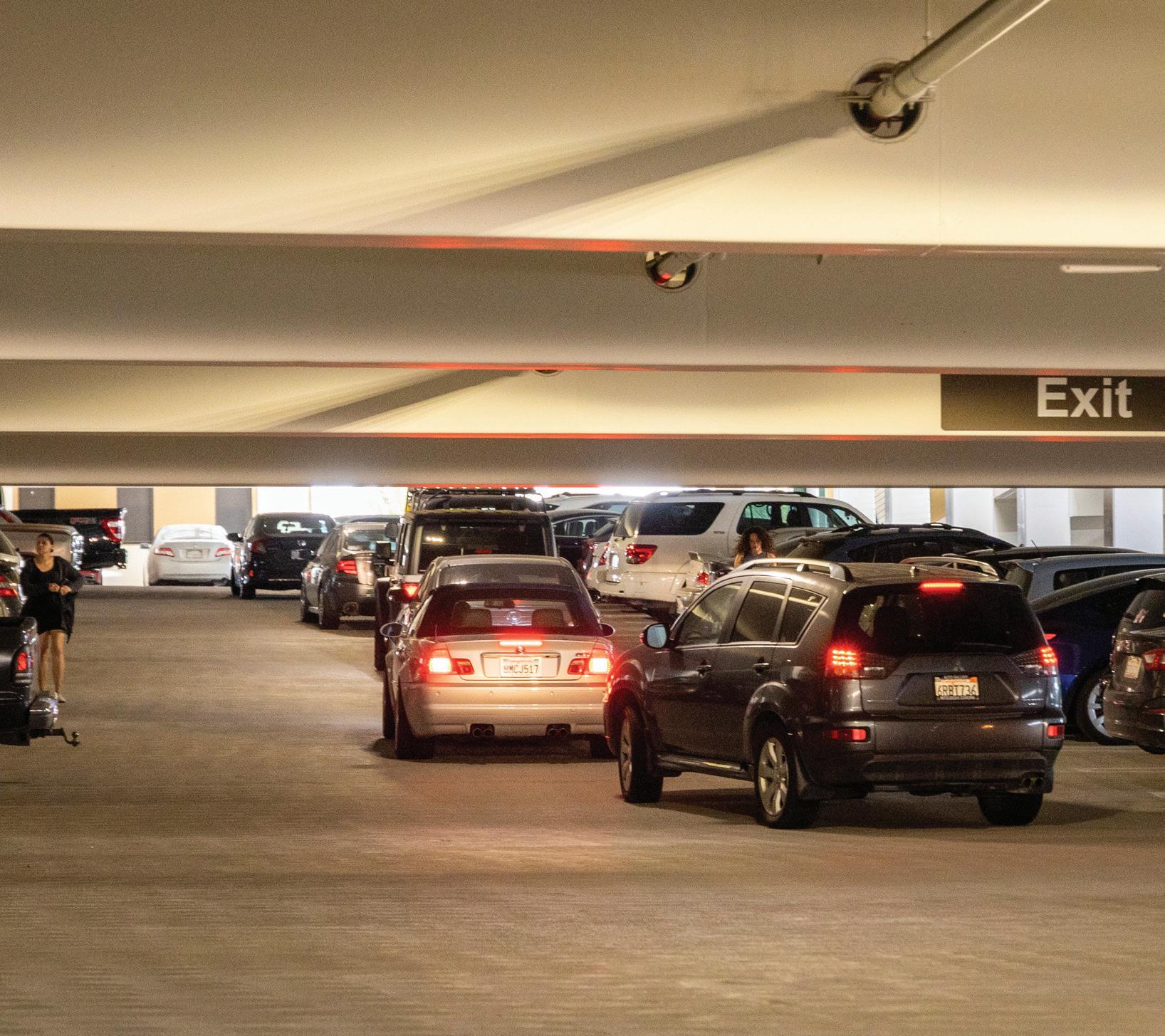
Dinco said that the major issues with parking occur when people are parking in a location where they should not be parking.
“We have enough parking for everyone, but (only) as long as everyone is parking in their zone,” Dinco said. “When people start parking out of their zone, that’s when we start having large backups and overflows throughout campus.”
Each student is assigned a zone in which to park based on where they live on campus if they are residential students. Commuter students are also assigned their own zone. When people park outside of their assigned area and in another area, there might no longer be enough spots for the students who are supposed to park in that zone, creating a domino
e ect.
These issues are exacerbated this year by the return to in-person Chapel. In addition, the school only o ers chapel on Tuesdays this year rather than Tuesdays and Thursdays, making parking worse on Tuesdays.
Dinco said the presence of unregistered vehicles on campus is another issue that contributes to parking struggles.
When unregistered vehicles park on campus, they take spots that should belong to students in that zone.
Unregistered vehicles occur often when students do not know how to get their parking permits. Dinco said the sticker-based parking pass system currently in place contributes to this issue because students often do not know how to get a parking pass or where to pick it up. To combat this issue, Dinco said the school is considering the possibility of transitioning to a digital parking pass system and is currently talking to a company about implementing a digital system that would use license plates as a digital pass.
Dinco said the school is also attempting to make the use of shuttles more common for students on campus. The campus has shuttles that travel between shuttle stops every 20 minutes, and these shuttles also travel to Adams Business Park, the airport and the Health Science Campus. However, the shuttles do not travel between Magnolia Crossing and main campus
because it is too challenging for the shuttles to loop around in an e cient way.
Safety Services is currently working to publicize the shuttle routes and stops by updating campus maps to include the stops, sharing them on social media and setting up signs at shuttle stop locations throughout campus.
However, Farr said she does not think the shuttles will help commuters overcome parking challenges.
“I don’t think the shuttle system would fix the problem because people still need a place to park when they get to campus,” Farr said.
Coria also said she does not think she would want to take the shuttle because of the shuttle schedule.
“Personally, I’ve never used the shuttle before but I don’t plan to use it because I like to be on my own schedule and not (have to) deal with running around to catch the shuttle back and forth,” Coria said.
Eventually, the school plans to construct a West Parking Structure.
“(We are) not quite there yet, but we’re getting there,” Dinco said. “When that happens, it will really open up a lot more parking for our students and residents and make it a lot easier. Until we get there, we need to make sure everyone is doing their part: registering their vehicle, parking in their zone and taking the shuttles whenever
that’s available, or riding with a friend when they are going to the same place. Being a little bit creative when going from place to place on campus really helps out on that parking.”
Dinco advises students to contact Safety Services if they cannot park in their zone. That means a vehicle is incorrectly parked in the zone. Then, Safety Services will know to target that area with parking checks.
“We want to make sure the residents that live in those areas can park,” Dinco said. “Sometimes it takes a little bit of enforcement, a little bit of management and a little bit of education, so we’re going to work on all three as we go through this.”
When it comes to major events and game days coming later on in the semester, Dinco said the university is still planning out how parking will look.
“One of the things that the university does is we understand that students are what we are here for,” Dinco said. “That is the population we serve and when we are doing pre-planning for major events, a lot of the sta will park a little bit farther away because we want to make sure the students can get to classes on time.
“That is what we are all here to do: make sure students have a good college experience, they can get to their classes, they can learn and they can graduate and go on to serve God and serve their community.”
WRITTEN BY ALEXZA BAHNMILLER
NEWSBriefs
METEOR HITS
A meteor was reported heading from the southwest over Ireland and across to Scotland on Sept. 14 at 10 p.m., according to The U.K. Meteor Network. The meteor traveled 300 km above Wales before crashing into the Atlantic near Islay. There were approximately 1,200 sightings of the reball, and some viewers claimed it resembled a rework. The U.K. Meteor Network determined that the reball was caused by a small space rock (most likely one that broke off of an asteroid) entering earth’s atmosphere. The reball looked greenish-white, and was seen burning through the air for about 20 seconds. The U.K Meteor Network reported that the meteor was likely to have fallen into the sea.
EARTHQUAKE SHAKES MEXICO
A magnitude 7.6 earthquake rattled Mexico’s central Paci c Coast on Sept. 19 at 1:05 p.m. The quake killed at least one person and resulted in building damage, according to Associated Press. Mexican President Andrés Manuel López Obrador con rmed there was no damage in the capitol, but power went out across Mexico City. The earthquake was large enough to trigger a “desert tsunami” 1,500 miles away in Armagosa Valley, Nevada. At The Devil’s Hole — the name for a cave covering a pool of water approximately 70 feet long and 10 feet wide — waves erupted up to four feet high, according to the National Park Service. This is the third large earthquake to occur in Mexico on the day of Sept. 19, with the previous ones hitting in 1985 and 2017.
QUEEN ELIZABETH II’S FUNERAL
Queen Elizabeth II was buried with her late husband, Prince Philip, on Sept. 19 at the King George VI Memorial Chapel in Windsor. There were 2,000 mourners at Westminster Abbey to witness the funeral and an additional 7.7 billion people viewing the funeral live on television, according to BBC reporters. In honor of the Queen, the United Kingdom had a moment of silence for two minutes at 11:58 a.m., and it was expected to be observed across the nation of 67 million people. The silence was broken by the singing of the U.K.’s national anthem, “God Save the King,” after 70 years of “God Save the Queen.” The new king, King Charles III, declared the day of the funeral a holiday so that citizens were able to view the ceremony and pay their respects.
CBU replaces ASCBU model with new Student Senate
by the student body. However, the new Student Senate has a di erent selection process.
body. This selection process is already underway with the goal of having the first set of senators selected by Oct. 1.
California Baptist University announced on Sept. 8 the creation of a new Student Senate and the dissolution of the previous student governmental body, Associate Students of California Baptist University (ASCBU).
Chris Hofschroer, dean of students, said the decision was made through careful analysis of issues and a general lack of e ectiveness encountered with the ASCBU model.
“Lack of student engagement and low voter turnout is what led to these discussions and is what eventually lead to the disbanding of ASCBU and their recommendation of creating a new Student Senate model,” Hofschroer said.
In the past, ASCBU student representatives were elected
Instead of holding student body elections, the schools and colleges across campus, as well as other departments such as Student Services, the International Center, Spiritual Life and Athletics, nominate student representatives.
The representatives must meet certain requirements, including having completed at least one semester as a fulltime traditional undergraduate student at CBU, having a 2.5 cumulative GPA or above and being in good standing with CBU from a behavioral standpoint.
Nominees are invited to apply to be a representative on the Senate. Each application goes through a committeebased review, ultimately resulting in 17 student senators to represent the student
“The Student Senate will serve as a formal conduit through which studentrelated concerns, views and interests can be communicated to university o cials,” Hofschroer said. “In support of the Student Senate, the university will provide meaningful opportunities for the Student Senate to meet with, receive information from and engage in dialogue with university o cers and university o cials.”
Joe Adcock, associate dean of students, will serve as adviser for the new Student Senate. He said he believes the Student Senate will be more e ective in representing student needs because it will have a clearer focus on existing to act as a way for students to interact
with university o cials about student-related concerns than ASCBU did.
“Our desire is to have senate be a good representation of our current traditional undergraduate population,” Adcock said. “The hope would be to give all students a ‘voice’ to communicate studentrelated concerns, views and interests to university o cials. I am excited for the Senate to become the bridge between the students and the university.
“It will not only be an opportunity for students to communicate to administration, but for the administration to communicate with the students. There are often times where student input is needed. I feel that Student Senate will become an ideal group to come to for this valued information.”
Justice Elohim, senior graphic design major, has been
involved with ASCBU since his sophomore year, when he served in the Senate as a residential representative.
Elohim also served on the Executive Council as ASCBU vice president from 2021-22.
During this time, Elohim said ASCBU helped plan many events, but there was an overall lack of student awareness about ASCBU.
“The shift from ASCBU to the new Student Senate may turn a few heads, but the plan for a transition has been in the works for years,” Elohim said.
“It was presented to us ASCBU members at simply the right time for a transition. As the university grows we need to have proper representation of our students.”
ASCBU made the decision to transition to this Student Senate model jointly with university o cials after looking into student representation
at a variety of colleges and universities. As CBU moves into this new era, Adcock said he is excited to work with the Student Senate to help it accomplish its mission. As a sta member who has seen CBU transition from CBC and expand from 700 students to nearly 12,000, Adcock’s main goal is to make CBU a great place for students to thrive.
“Growth brings change, and I’ve seen a lot of it,” Adcock said. “Change is good, and I am very excited about being a part of this new chapter in student representation here at CBU.
“I bleed Lancer Blue, and I want nothing more than to make CBU a place that students will cherish in their heart for the rest of their lives. My hope is that the Student Senate will share this desire with me and that together we can work to make that desire become a reality.”
Many students have found it dif cult to nd parking as events such as Chapel return to campus as in-person activities.
Camille Grochowski | Banner
3 September 30, 2022 · Volume 70 · Issue 2 NEWS
EMILY MCGINN EDITOR-IN-CHIEF
VISION
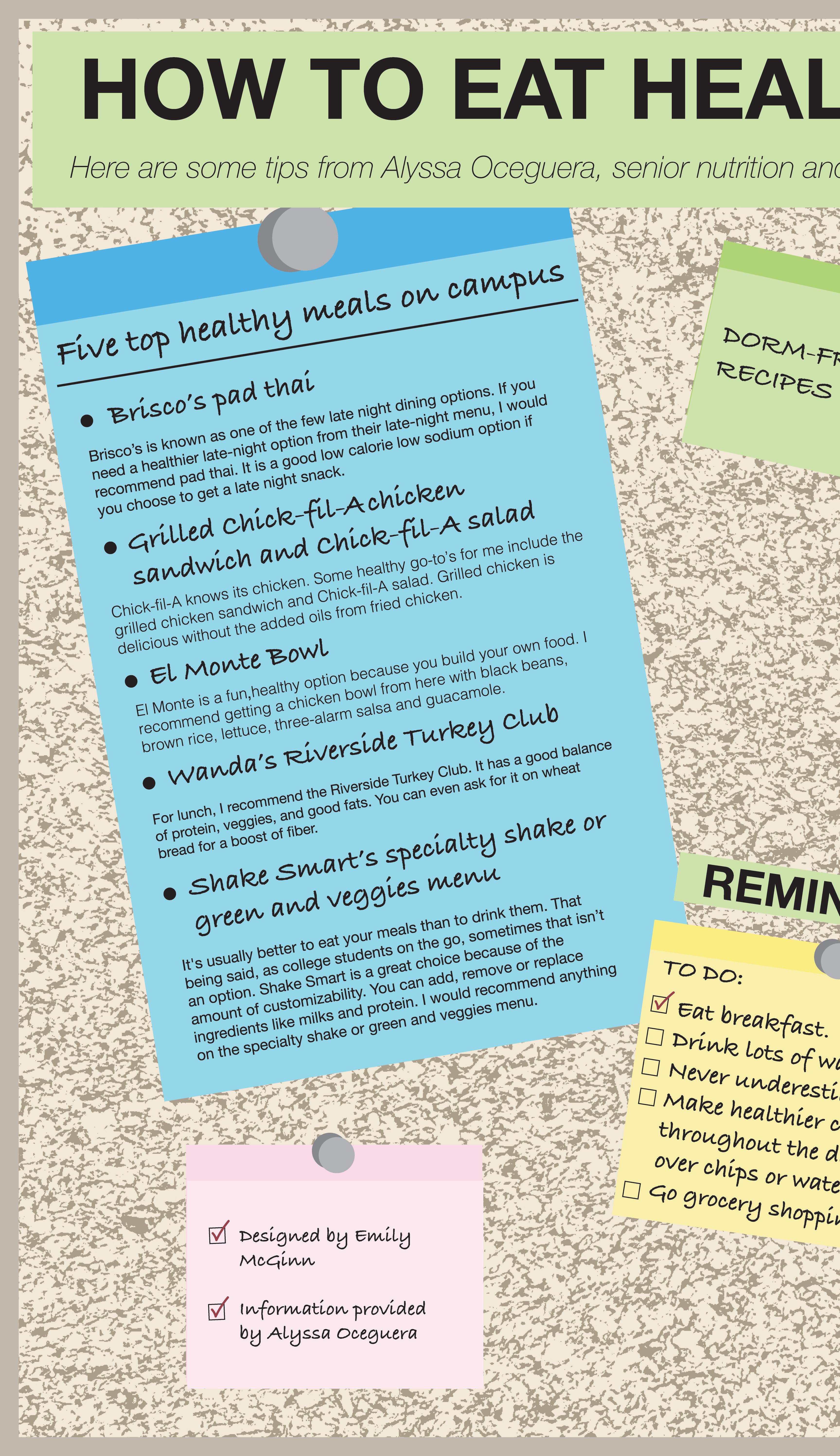
4 September 30, 2022 · Volume 70 · Issue 2
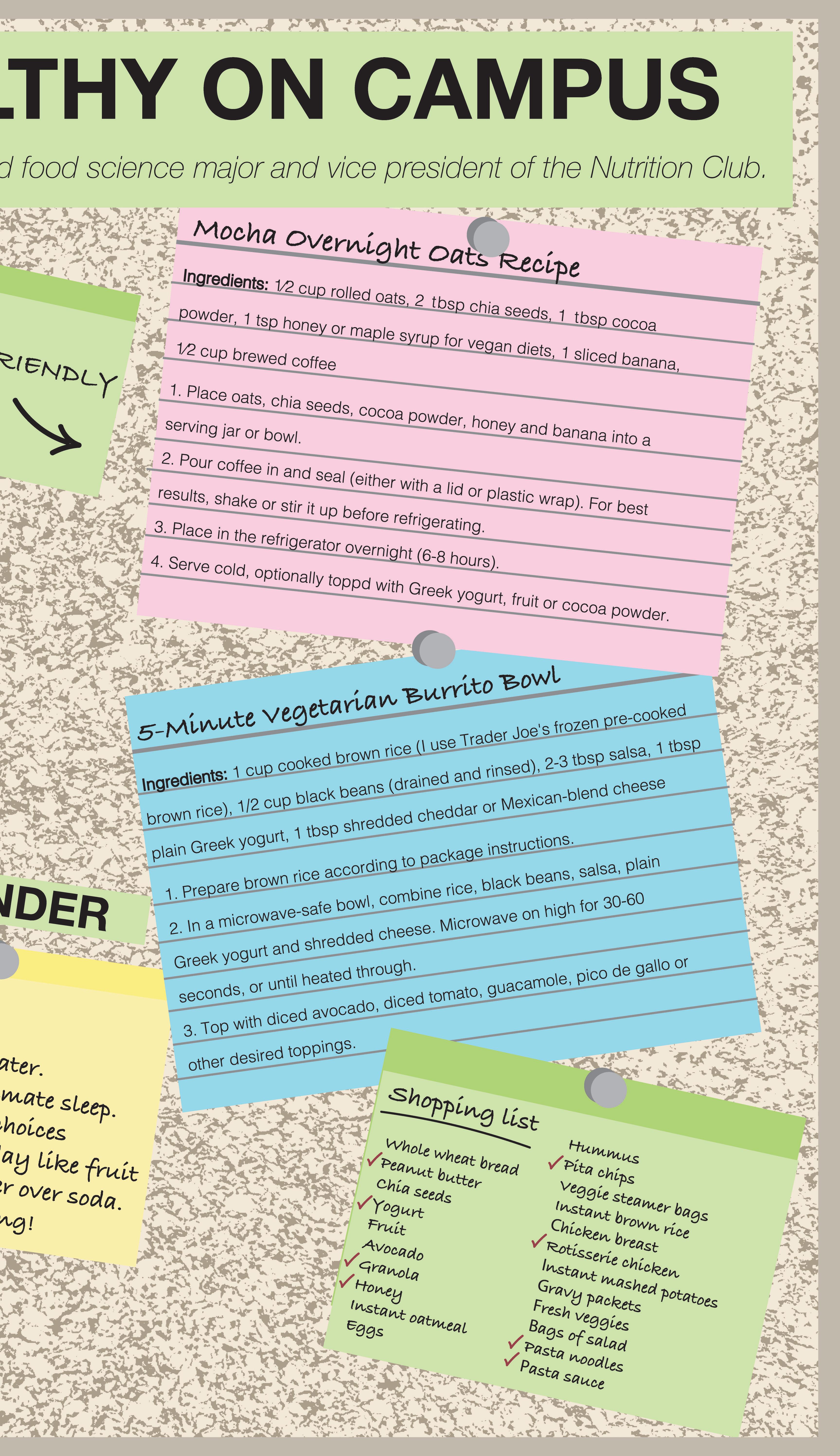
5VISION September 30, 2022 · Volume 70 · Issue 2
Do sleep tracking apps track sleep quality accurately?
BY EMILY MCGINN EDITOR-IN-CHIEF
In this digital age, people use many apps to enhance health. One sector of these apps is sleep-tracking apps, which often o er a variety of features, from white noise to data about movements during the night. Many apps even o er a measurement of sleep quality, and apps such as Apple’s own Sleep app on Apple Watch even provide information about the time spent in each sleep stage: awake, rapid eye movement (REM), core and deep.
Kaiden Joseph, junior biomedical sciences major, said that he believes having the ability to track one’s sleep and stages of sleep is beneficial.
“You would be able to see the quality of the sleep you’re getting and figure out ways to improve your sleep,” Joseph said. “REM sleep is the most important part of a good night’s rest, so tracking this would be very helpful. You could also use these patterns to determine if any other health issues are present as a result of poor sleep.
Overall, I see a net positive result coming from tracking someone’s sleep.”
While there are potential health benefits to tracking sleep patterns, is it actually possible for an app to accurately measure
these elements of a user’s sleep patterns?
Sleep trackers come in several forms. Many apps work as bedside trackers, which collect information about body movements, breathing and sleeping environment during the night. Wearable sleep-trackers, such as the Apple Watch Sleep app, gather data about movement and heart rate, and some also monitor breathing.
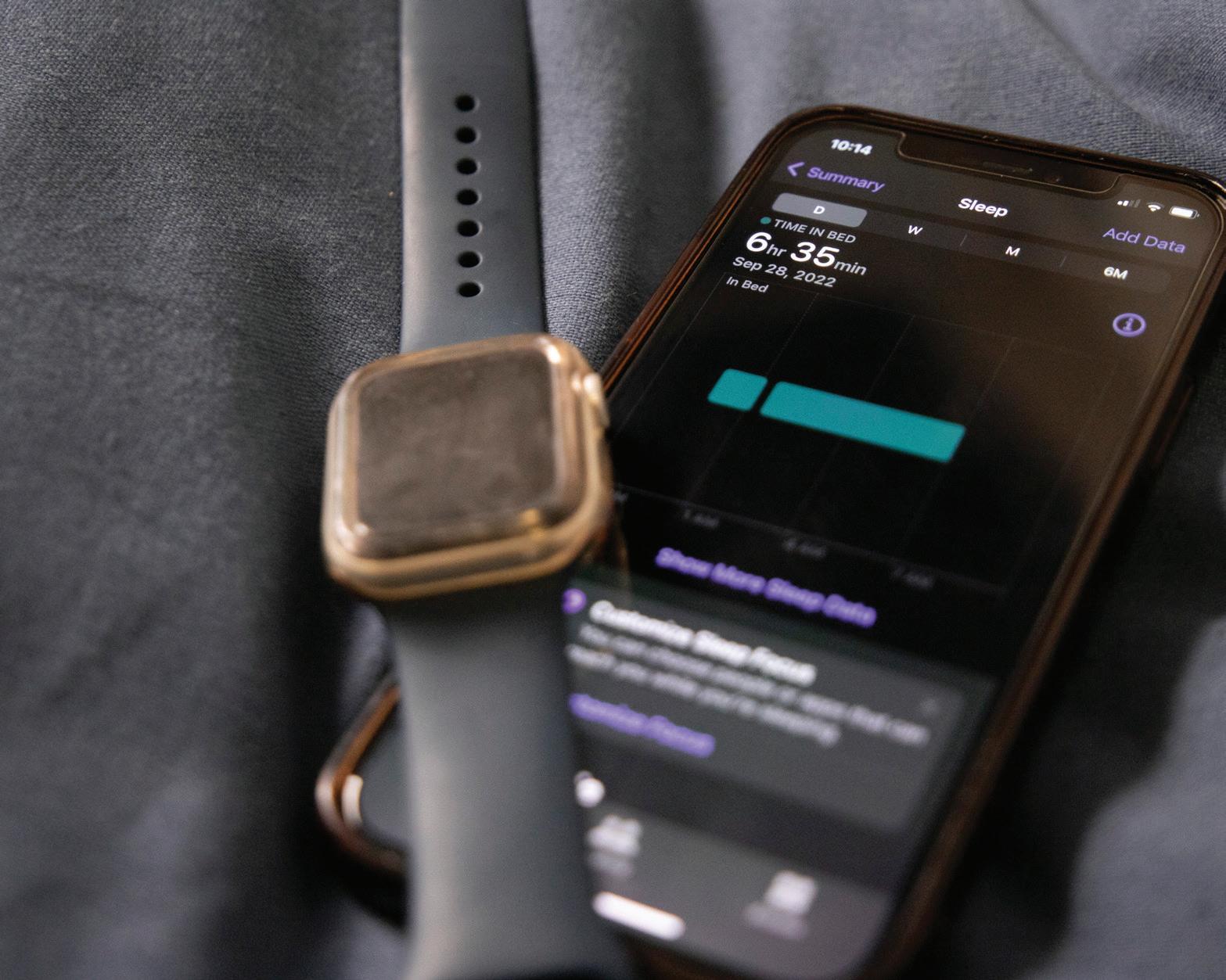
There are four major stages of the sleep cycle, according to the Sleep Foundation. During the first stage, which lasts about one to five minutes, the body has not fully relaxed and brain activity has begun to slow.
During the second stage, which is a deeper non-REM sleep, the body experiences a decrease in temperature, a relaxation of muscles and a decrease in breathing frequency and heart rate.
During the third stage, known as deep sleep, the body relaxes more, leading to relaxed muscles, slow pulse and a slow breathing rate.
During the fourth stage, known as REM sleep, the sleeper experiences their most vivid dreams and the brain becomes highly active, accelerating heart rate and leading to irregular breathing. Most muscles also become temporarily paralyzed during REM sleep.
Sleep-tracking apps attempt to use these di erences in movement and breathing among the stages of sleep to dis-
tinguish between the di erent stages to rate sleep quality and share data about sleep cycles.
However, users should be careful about how much faith they place in the apps. While measuring movements and similar parameters during sleep can help create estimates about sleep stages and sleep quality, sleep-tracking apps ultimately cannot be expected to provide completely accurate information about sleep patterns.
“A sleep tracker can make an educated guess about your sleep stages,” reads a Mayo Clinic article. “But the only way to accurately identify what stage of sleep you are in is to measure brain activity during a clinical sleep study (polysomnography). None of the consumer devices on the market capture this kind of data.”
Esmeralda Gonzalez, junior psychology and philosophy double major, said she can see the value of these devices, though she does not entirely trust their accuracy.
“I think that tracking sleep patterns would be helpful because normally the devices used also show you heart rates, and when it comes to sleeping I’ve seen some that monitor when you are having trouble sleeping such as waking up during the night or even when the person is moving around during their sleep cycle,” Gonzalez said. “With that information, the person is able to find ways to sleep better. I wouldn’t completely
trust an app that tracks sleep, but I would try it just to see exactly what it would tell me.”
Although users should be cautious of data collected while using sleep-tracking apps, it can still be helpful to use other features o ered by the app, such as alarms, white noisemakers, screen time limits and information about when a user goes to bed and wakes up. These features can provide concrete ways to improve sleep habits.
“I personally don’t track my sleep patterns and it’s partly because my sleep schedule is so
messed up,” Joseph said. “I do believe that tracking my sleep and seeing how bad it might be may help me think more about my sleep and fix my schedule.”
However, sleep-tracking mechanisms can also lead to orthosomnia, a newer term to describe the obsession with reaching an optimal level of sleep due to tracking sleep through devices.
“For some people, using a sleep tracker leads to increased feelings of anxiety,” reads the Mayo Clinic article. “Are you staying up late to fiddle with
your device? Feeling overly anxious about meeting your sleep goals? Or lying awake in bed thinking about how you’re not sleeping? If so, using a sleep tracker probably isn’t adding value to your life. It’s OK to let it go.”
Ultimately, it is best to speak to your doctor about sleep-related concerns.
When using sleep-tracking apps, use features to help improve sleep schedules, but remember that any data about sleep patterns might be inaccurate.
Multiple factors may play a part in determining overall happiness
BY OLIVIA LENNING ASST. LIFESTYLE EDITOR
Happiness: universally searched for, yet seldom found. Philosophers, theologians, psychologists, reformers, politicians and the like, have pondered the question, “How can we control happiness?” since ancient times. Now, modern psychology has made significant discoveries in the area of well-being, finding that happiness may be more within our reach than we think.
Hannah Woods, master of counseling psychology student, shared her personal and academic insights on the topic.
Woods said she defines happiness as “the presence of fulfillment that is derived from di erent areas of life, including relationships, accomplished goals and significant events.”
Woods listed many of the different factors that contribute to our happiness, many of which are areas of life within our immediate control.
“Personal happiness is affected by things such as those
closest to us, our ability to connect with others, our own personal ability to succeed at what we set our intentions on, our spirituality, how we view and identify ourselves, our self-esteem and confidence and ultimately how we respond to our environment,” Woods said.
Woods said she believes happiness is, in fact, within the control of each individual.
“I believe for the majority of it all, individuals have the ability to manifest happiness in their lives,” Woods said. “As individuals, we get to choose how we respond to challenges and negative circumstances. Choosing a growth mindset and engaging in well-disciplined, positive responses is a recipe for potential happiness.”
Woods views finding happiness as both an ongoing and holistic journey. Along with her academic insight on the topic, Woods shared how she personally seeks to find greater joy within her day-to-day life.
“I engage with those who are significant in (my) life, partake in activities I find enjoyment in
like watching shows and seek encouragement from my daily Bible readings,” Woods said.
Dr. Virgo Handojo, professor of psychology, has researched the concept of happiness. Within Handojo’s research, he defines happiness in two concepts. One focuses on pleasure and decreasing pain, and the other focuses on self-sufficiency and purpose.
“There are two di erent concepts,” Handojo said. “Hedonistic is (seeing) happiness from the subjective point of view, focusing on pleasure. The more you experience pleasure, the higher your happiness. Eudaimonic (is) how high your spirit (is). We measure it through whether the person can live independently, whether they have purpose in life (and) whether they can be self-contained.”
Handojo shared that peer-reviewed literature reviews have shown about 50%
BIBLE STUDY BASICS
”Be diligent to present yourself approved to God, a worker who does not need to be ashamed, rightly dividing the word of truth.”
of our overall happiness is predetermined by genetics. About 20% is a ected by circumstances outside our control and 30% is within our control through intentional activities. His research showed that 15% of our well-being is a ected by how we love God, ourselves and others.
“In my study, I try to operationalize love (of) God — spirituality — love (of) other people and love (of) yourself,” Handojo said. “The largest factor that makes you happy is to love yourself, so you have to take care of yourself.”
He shared that he uses two instruments to measure how individuals can love God in a way that also contributes to overall well-being. These include our religious participation (church attendance and spiritual disciplines) as well as how we involve God as we cope with hardships. If we can view God positively as we cope, we are more likely to
feel happier and more content in life.
Handojo also shared practical advice on increasing happiness in day-to-day life.
“The most important factor is having close relationships — how you build community,” Handojo said.
He explained that we must feel close and secure to those around us and secure in ourselves to flourish.
Intentional gratitude is a way in which we can also take care of ourselves and increase our happiness in daily life.
“You can nurture yourself by thanksgiving, feeling gratefulness,” Handojo said. “Every day, you can open a journal and then (you) can write down what good things happened in (your) life.”
Handojo also stressed the importance of goal-setting and finding purpose in life. Goal-setting allows us to live intentionally and adds meaning to our life, which is vital to happiness. He explained that our goals must be challenging yet not too di cult to obtain. Accomplishing goals boosts our
sense of fulfillment in life.
Handojo said that overall happiness is something we can control and continually grow and develop in.
“Happiness is not like an object you can achieve,” Handojo said. “It is a process.”
Alyana Placencia, freshman psychology major, shared how she finds happiness and maintains well-being within her own life.
“I make plans with at least one friend for a meal or a study session so I can interact with others and not be isolated and alone with my thoughts,” Placencia said. “It helps me maintain a positive mentality while engaging with my friends. I typically end my day with reading the Bible. It is not only calming but reassuring reading the word of God and applying it to my daily life.”
6 September 30, 2022 · Volume 70 · Issue 2 LIFESTYLE Placencia’s advice illustrated the significance and legitimacy of Handojo’s research findings. If we love God, others and ourselves within our own lives, we can control our level of happiness from day to day.
RESEARCH
for key themes and ideas, and for transition words and phrases.
READ
different translations to provide a more well-rounded understanding of the text.
LOOK LOOK CREATE ASK
at the meaning of the original language.
cross-references, which point us to other passages in the Bible that have similar information.
a Bible annotation system to help organize your thoughts.
where the book fits in the biblical timeline.
USE KNOW the historical and cultural context of the book or passage.
“What did the author originally intend this text to mean?”
“Happiness is not like an object you can achieve. It is a process.
Dr. Virgo Handojo, Professor of psychology
Emily McGinn | Banner
Photo Illustration by Charissa Graves | Banner
There are several different apps available to track sleep patterns.
2 Timothy 2:15
LIFESTYLE
Lifestyle Tries: Five-minute co ee body scrub
BY ALEXZA BAHNMILLER MANAGING EDITOR
As the semester continues, it is important to remember the importance of self-care. To help take some time for yourself, here’s a quick DIY body scrub that is not only relaxing, but rejuvinating as well. This body scrub helps rid the skin of dead skin cells, moisturizes dry spots and opens up the senses with the bold combined smell of coffee and vanilla.
Step 1: Gather your supplies. You’ll need 1/2 cup co ee grounds, 1/2 cup brown sugar, 1/2 coconut oil (or vegetable oil), 1 tablespoon vanilla extract, a spoon for mixing and a container to keep the scrub in.



Step 2: Combine the co ee grounds and brown sugar. Mix well.
Step 3: Add oil and vanilla extract. Mix well.
Step 4: Ready for use! Make sure to add water to your skin before softly applying the scrub
in a circular motion, and rinse well. Stop if irritation occurs. Skin should be left feeling soft and smooth.
Step 5: To save the scrub, make sure to cover the container with a lid or plastic wrap.

Scrub should last about two weeks, and expires within 6 months. Follow up scrub with a favorite lotion for additional hydration. Based on preferance, additional oil such as spearmint can be added for scent modification.
Understanding learning style might not be the most helpful way to learn
BY VALERIE LA PONZA ASST. LIFESTYLE EDITOR
In many high school career classes, it is common practice to require students to take learning style assessments, which reveal how someone learns best. Results from these sorts of tests can range from visual to auditory or bodily-kinesthetic. But what if everything that is said about this well-established theory of learning is not what it seems?
The theory of learning styles has been around since the 1960s, outlining that students learn information best when it is presented in their learning style, according to Michigan State University’s College of Education. When first introduced, the theory caught on quickly, gaining traction over the years as students found relatability in their learning styles.
Even today, students like Alyana Placencia and Taryn Galindo, sophomore psychology majors, know their learning styles and find they succeed more when in a class format that matches their learning styles.
“I personally am a visual learner, and being able to map out what it is that is being said or taught is much easier to comprehend,” Placencia said. “I find most of the classes I have had to be more visual and auditory. Whether reading from the textbook or presenting a slideshow, it seems to be the main approach with teaching.”
Galindo said she works best with a visual, active approach to learning.
“I prefer reading and writing
when I am learning because it helps me focus my thoughts and practice what I need to work on,” Galindo said. “Auditory is definitely the hardest for me to learn. For some reason, I can’t process auditory information as well as written information.”
Galindo added that because she is a visual learner, she always watches television with subtitles so she can read and understand what characters are saying.
However, science may not necessarily support the existence of learning styles.
Dr. Erin Smith, professor of psychology, explains that she does not think there are specific learning styles that correspond to each individual.
When asked how many learning styles she believes to exist, Smith said, “None.”
“I mean, I say that and I laugh, but I mean it,” Smith said.
“As I mentioned, learning styles are a thing that exists in popular culture but aren’t actually real.”
Smith explained that our reliance on the concept of learning styles comes from heuristics — mental shortcuts that help everyone function daily, which can take the form of assumptions about the world or reliance on past experiences to draw a road map for future activities. Without heuristics, it would be impossible to function well enough to even leave our houses.
But why does society continue to cling to these outdated ideals, especially if they have been shown to do more harm than good for students by giving students a preconceived notion
of how a class will go depending on its teaching structure?
Smith explained that because the educational system is consistently playing catchup with new research, schools tend to be at least a decade behind the research. This is for good reason — if schools changed their learning tactics at the drop of a hat, students would end up learning less and finding more di culty in adapting to the newest research. However, in the case of learning styles, they are still being taught in schools, but research may find that learning styles are ine ective and, at times, even harmful.
For students put into a class that is not taught in the way that the student learns best, unconscious biases take a toll.
When students know they are in a class that is not taught in their learning style, they might not try as hard, which translates to worse grades and a subconscious connection between incompatible learning styles and failure.
In the end, Smith said she wants readers to remember that students should not define themselves by their learning style, but rather label themselves as hard workers or as strong students.
“Sometimes the hard work is going to involve auditory activities,” Smith said. “Sometimes it’s going to involve visual activities. Sometimes it will involve kinesthetic activities. But when you are committed to learning rather than a particular way of learning, it actually gives you a lot more freedom to do the learning you desire to do.”
RESTAURANT
ALEXZA BAHNMILLER I MANAGING EDITOR
Can’t decide between satisfying your sweet tooth with boba tea or switching it up with something salty like twisted and salted fries?
Lucky for you, Tim Boba o ers both. Located only 6.6 miles from California Baptist University (approximately 10 minutes), this family-run restaurant is both a boba shop and an Asian cuisine restaurant.
First, a little fun fact about the restaurant name: according to its website, the name Tim in Vietnamese means “heart.”
Now, let’s get to the good stu . Tim Boba’s menu is a decent size and has variety, with options for drinks as well as food. The drinks range from smoothies and bobas, to plain teas or co ees, and the food ranges from wonton soup to County Fair-lookalike curly fries. Although the food is simple, it comes out rather fast and is easy to share with a group.
However, the boba selection is definitely the highlight of the menu, and many of the fruit variations are made and topped with fresh fruit and warm boba. Not only that, but the cups are aesthetically pleasing and reusable — at no additional cost.
While checking out, make sure to get a punch card, as after every 10 drinks purchased, you get one on the house.
My favorite part about Tim Boba is not only its amazing selection of beverages (looking at you, Watermelon Slush Boba), but the fact that it caters especially to students.
If you cannot tell that this is the case by looking at the walls decorated in hand-painted murals of di erent nearby school logos (including CBU’s), maybe the whiteboards scattered across the re-
maining restaurant walls will give it away. The whiteboards are open for anyone to use, and they often fill up fast, with groups of students tutoring each other or studying before a big test. Also, no need to worry about a phone or laptop dying, as charging ports are readily available underneath all the tables.
If sitting at the tables gets uncomfortable, there are also couches by the windows.
The best part? Tim Boba o ers a printer in the back that is free to use. There is a maximum number of pages that you can print, but it is still a generous thing to o er to customers.
To top it o , Tim Boba o ers a student-only promotion where if you bring in your report card at the end of the semester and you have all A’s, you get rewarded with a free boba of any size.
Tim Boba is open from 1 p.m. until 12 a.m. every day, but be warned, the place gets packed around 9 p.m., so if you want to get a good seat next to a whiteboard, try to get there before then.
Workout classes and routines can be advantageous for students
BY VALERIE LA PONZA ASST. LIFESTYLE EDITOR
Regular and regimented exercise is an essential yet often overlooked part of life. Many college students find they do not have enough time for an entire workout between collegiate responsibilities and outside work.
However, according to the Centers for Disease Control and Prevention, as little as 30 minutes of exercise a day can keep someone healthy, help ward o heart disease, prevent type II diabetes and even lower the risk for certain cancers, including esophageal, lung and stomach cancers.
With California Baptist University’s Recreation Center, stocked with exercise equip-
ment, friendly workers and invigorating classes, a healthy life is not only possible, but also entirely attainable.
Victoria Tamayo, fitness lead and junior exercise science major, explained that exercise “can promote an overall well being for students’ mental health.”
“The Recreation Center can be a great resource to decompress after a tough week or a busy schedule,” Tamayo said.
Jenna Beekhuis, junior photography major and Zumba instructor, said that working out helps her relieve stress and improves her mental health.
“Getting an hour to just dance it out in my class is so rewarding, and it’s a major plus it helps keep me physically healthy as well,” Beekhuis said.
The classes at the Recreation Center are a place for fitness, but also a place for the community.
Grace Lantz, junior public health major, explains that her role as a kickboxing instructor plays a big part in the community aspect of the classes o ered by the Recreation Center.
“Personally, as an instructor, I am there to push students to become stronger versions of themselves, but also, I am there as a friend and a peer that understands the same struggles they might be going through,” Lantz said.
Lantz laid out a few key points when asked why regimented exercise is so essential. She explains that, for college students, exercise is incredibly important because, due to

classes, students end up sitting and spending long hours in front of computer screens. She added that exercise is also a fantastic stress reliever and can aid in creating a sense of self-discipline with regard to our physical and mental health.
Tamayo wants all who are worried about going to the Recreation Center to exercise to know that they o er classes that can help beginners ease into working out.
“We o er weight room orientations to all students, (and) this is a great way to get handson experience with the machines and equipment at the Rec Center,” Tamayo said.
If you would like to begin your fitness journey, reach out to the fitness instructors at the Recreation Center for guidance.
Alexza Bahnmiller | Banner
Alexza Bahnmiller, managing editor, shares steps to creating the perfect scrub.
My favorite part about Tim Boba is not only its amazing selection of beverages (looking at you, Watermelon Slush Boba), but the fact that it caters especially to students.
“
This body scrub helps rid the skin of dead skin cells, moisturizes dry spots and opens up the sense with the bold combined smell of coffee and vanilla.
“
7 September 30, 2022 · Volume 70 · Issue 2 Photo courtesy of Recreation There are a variety of different group classes available for all skill levels.
REVIEW: TIM BOBA
PERSPECTIVES
Student mixer kicks o TWIRP week

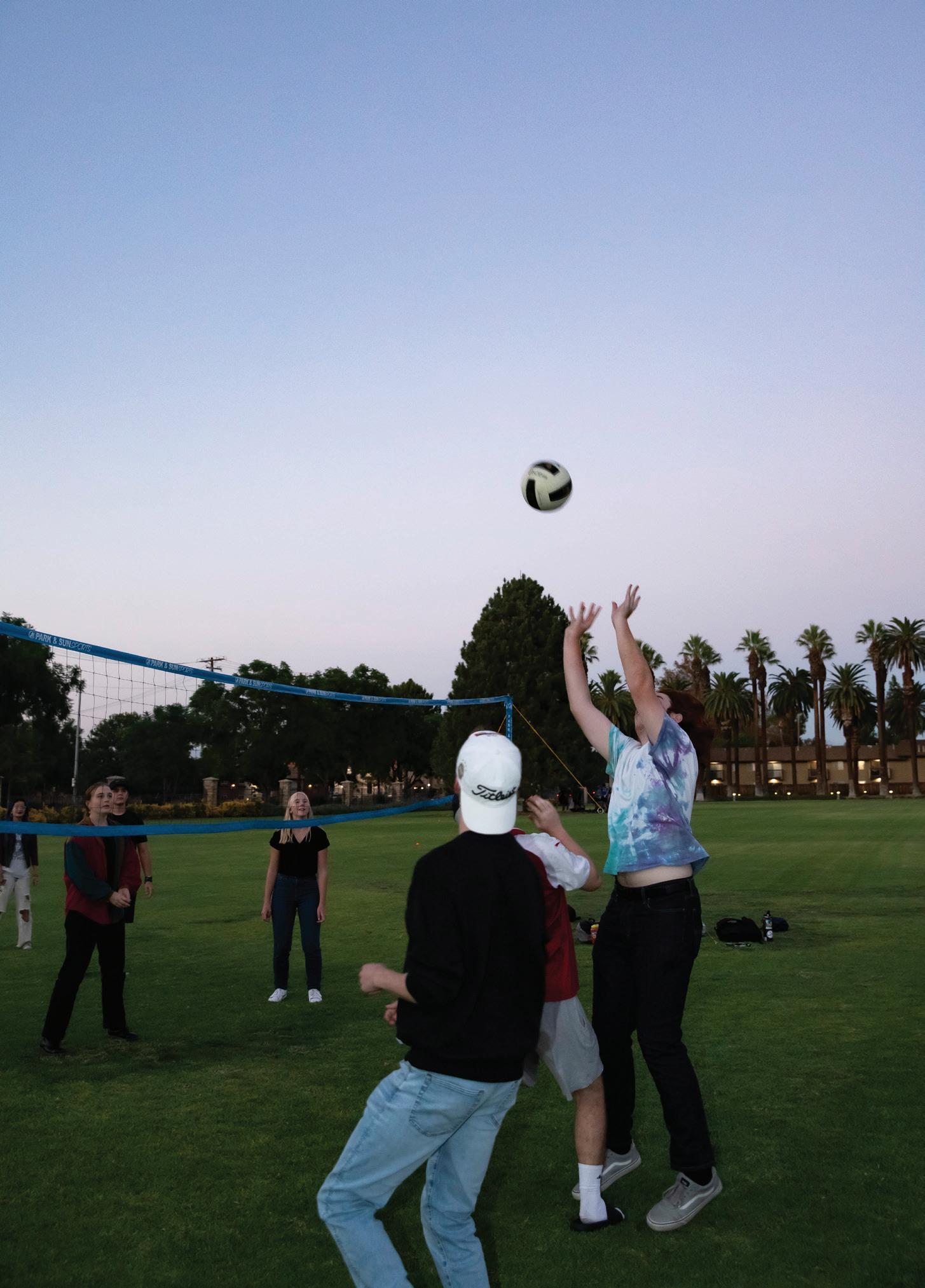
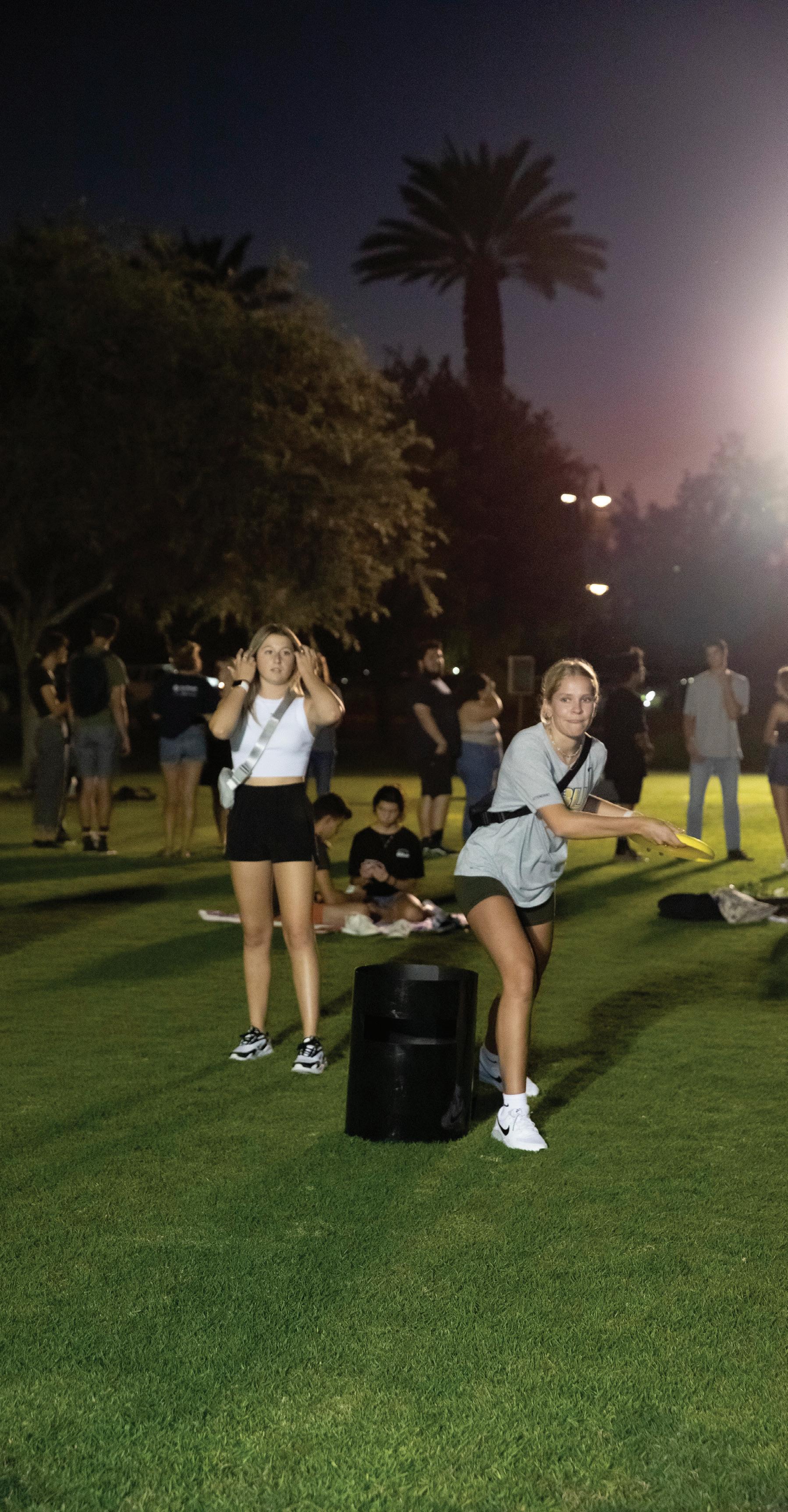
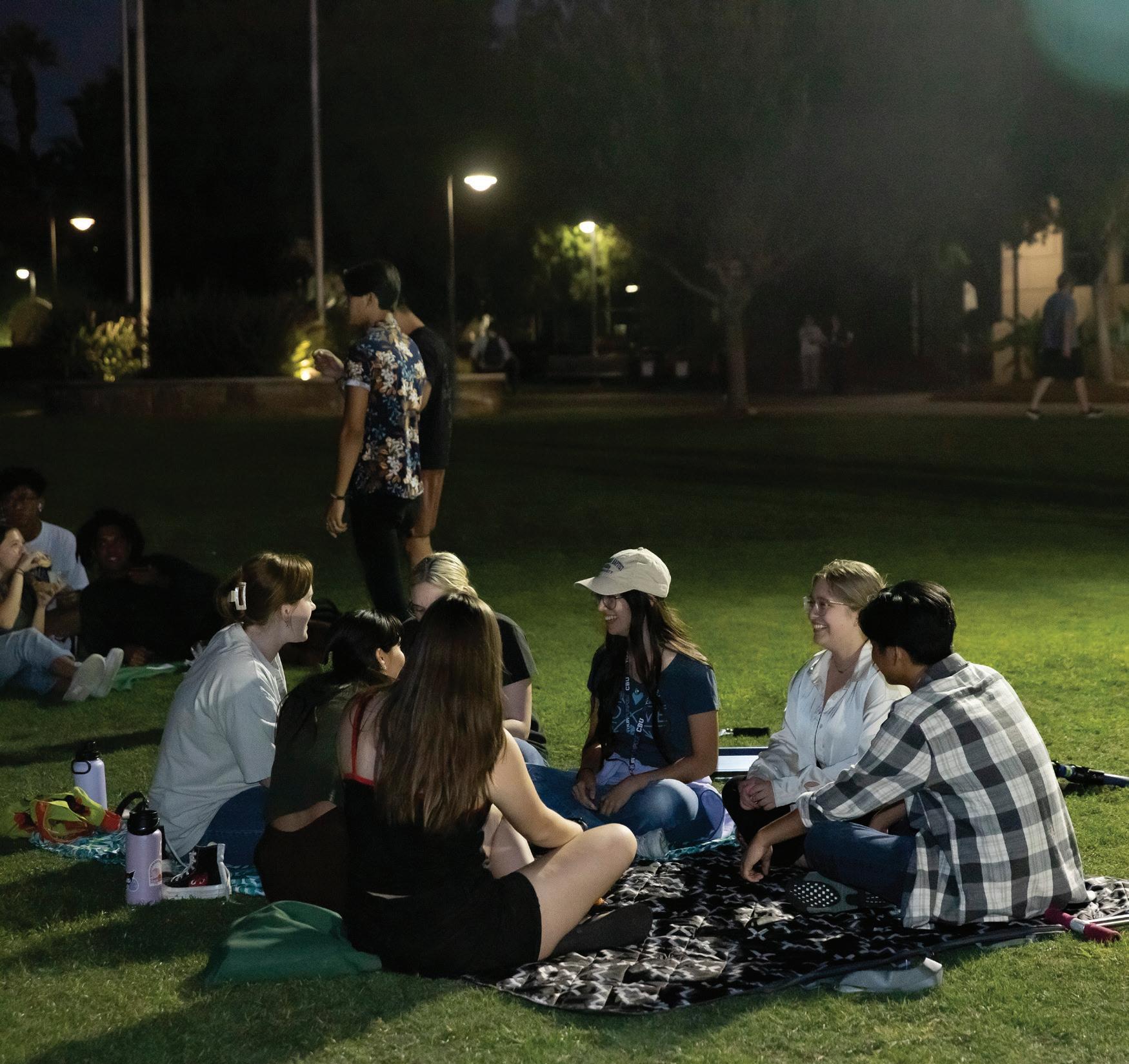
 1. Hannah Scherer, junior graphic design major, competes against Grace Letherer, sophomore art education major, in a game of bean bag toss.
2. A group of students plays volleyball.
3. Rebekah Wilgenburg, sophomore marketing
major, throws the Frisbee to her teammate who hopes to make a goal by dunking it in the trash can.
4. A group of students play a game of Catch Phrase.
5. Asianae Gaines, junior mathematics major, Keyana McArdell, sophomore pre-nursing major, Sarah Ukpong, senior health science major, and Kayla Saravia, senior biomedical sciences major, relax on blankets during the mixer.
Photos by Kia Harlan
1. Hannah Scherer, junior graphic design major, competes against Grace Letherer, sophomore art education major, in a game of bean bag toss.
2. A group of students plays volleyball.
3. Rebekah Wilgenburg, sophomore marketing
major, throws the Frisbee to her teammate who hopes to make a goal by dunking it in the trash can.
4. A group of students play a game of Catch Phrase.
5. Asianae Gaines, junior mathematics major, Keyana McArdell, sophomore pre-nursing major, Sarah Ukpong, senior health science major, and Kayla Saravia, senior biomedical sciences major, relax on blankets during the mixer.
Photos by Kia Harlan
September 30, 2022 · Volume 70 · Issue 2
1 2 5 3 4 8
Audience energy a ects athletes
BY HANNAH GORDON ASST. SPORTS EDITOR
There is nothing more exciting than a packed home stadium. The people have gathered here for one reason. For about 90 minutes, we are all united against a common enemy. All our di erences and disagreements melt away as we cheer as one team for one team. But does the team even notice? Do fans contribute in any way aside from noise and chaos?
Surely, the game would not be the same without the roars of excitement emanating from the fans. The cheers create an atmosphere and form a major part of the entertainment.
“The crowd is the energy,” said Dr. Ed Garrett, professor of sport and performance psychology. “They are the vibe.”
But do the fans a ect game play?
The answer may depend on the individual.
“Each athlete psychologically is a little di erent,” Garrett said. “Most will thrive o of (cheers), but it can create a level of nerves positively or negatively. The challenge of the athlete is to have those nerves be more facilitating and less debilitating. If they can view the energy o of the fans as facilitating, giving them a little more boost, supporting them, being there when things might not go well, they can recover faster. Or they can go the negative side where it is, ‘I’m playing in front of a lot of people, now I’m nervous and I can’t function and I can’t focus on what I need to focus on.’”
Garret Ostrander, infielder for the men’s baseball team, is impacted positively by fan engagement.
“There’s nothing better,” Ostrander said. “When you feel the support and encouragement from thousands of fans, it only increases the competition and your performance.”
The age and experience of an athlete may a ect the reaction to fans. As a college athletics program, for a lot of our athletes this may be the first time that they play with that pressure from the crowd.
“Its harder as a freshman, easier as a senior because you get used to that environment,” Garrett said.
Ostrander has experienced this need to become accustomed to the large fan turnout.
“There’s definitely more pressure that comes along with it, but after a while, you get used to playing in front of a lot of people and you find the fun in it,” Ostrander said.
While there is no concrete evidence of the e ect of fans on a team, the evidence takes the form of the experiences of athletes. An environment that is supportive and exciting is beneficial for many athletes.
“That atmosphere, that en-
vironment is something the athletes thrive o of,” Garrett said. “They expect it. It’s a cultural thing. I love it now that at soccer when we score a goal, the lights dance and everything. It brings about a di erent environment that is more supportive of the athlete’s success and encouraging that success, to continue to thrive and be the best they can be.”
Ostrander said he values the atmosphere and thrives on the energy of the fans at CBU. However, he also acknowledged how cheers may a ect a team nega-
Student-athletes share their workout routines and habits
BY HANNAH GORDON ASST. SPORTS EDITOR
From cheerleaders to basketball players, all athletes have one thing in common: they work out. Dedication to their sport leads them to enhance their performance through personal training.
Marissa Warren, senior liberal studies major and member of the cheer team; Leo Mendez, member of the men’s soccer team; Garret Ostrander, sophomore business major and member of the men’s baseball team; and Trinity San Antonio, sophomore photography major and member of the women’s basketball team, shared their workout routines with us.
Q: How do you typically structure workouts?
Warren: “I’ll start with stretching and I’ll go in with an idea of what I’m going to hit that day. (I’ll) do core, do my workout, then I’ll go to my room and try to do a YouTube stretch video at the end of the day because (working out) makes you real sore.”
Mendez: “I’ve had the same workout routine since I was 16. I usually start my day o with a good breakfast which is usually eggs and oatmeal before school. After school, I have soccer practice and once I’m done I have another meal. I come home and rest for a few hours and do a bit of homework before I have my last workout of the day, which is weightlifting.”
Ostrander: “I normally structure my workouts based on specific parts of my body as well as taking into account what time of the year I’m working out. During the winter, I’m preparing my body for the season coming up in the spring, so it would be four days a week of
intense lifting versus in-season lifting, which could be light fullbody lifts every day to maintain strength.”
San Antonio: “Typically, I structure workouts depending on what I want to do specifically geared torwards my sport or for strength training. On the court stu is more cardio, conditioning and game reps while in the weight room is heavy weight to build strength or mobility to take care of my body through all the stress it endures.”
Q: What kind of workouts do you do?
Warren: “I like to do weight training the most, but one thing that’s important for cheer is agility and endurance — not for running the mile but more for sprints, because in a cheer routine I go from high energy fast movements to moments where I’m not doing anything and I can just breathe. So you kind of have to learn how to take those little moments and make the most out of them. Sprinting is really important, but I hate running so I like to do spin classes.”
Mendez: “The kind of workouts I do on a daily basis is cardio, which consist of sprints, agility movements and endurance workouts. When it comes to my weight training, I train two di erent muscle groups each day to target each area and tire the muscle. I do biceps curls, barbell curls, shoulder press, bench press, leg press, squats and core exercises.”
Ostrander: “I stick to baseball-specific workouts, which focus on core, rotational power, full-body stability and explosive movements that are incorporated into all of the common lifts such as bench, squat, deadlift, etc.”
San Antonio: “The types of workouts I do are either ball
handling or shooting, and then in the weight room, it’s isolation movements, whether that’s for back, arms, legs or full body.”
Q: What areas do you target to enhance performance in your sport?
Warren: “Your target is very dependent on what position you are. As a back spotter, I target back and shoulder. Core is basically for everything you do, but for the most part it’s whole body and endurance.”
Mendez: “I target my legs and core for the most part because they’re the most relevant muscle groups in soccer.”
Ostrander: “Legs are a major focus for baseball and having a strong, explosive lower half is key to maximizing your performance. Along with that, focusing on rotational power is important, and that involves many parts of the body such as the core and legs.”
San Antonio: “Specific areas I target for basketball would have to be core and shoulders. All our movements when it comes to shooting and running come from having a stable and strong core.”
Q:What other healthy habits do you practice that contribute to performance and overall health?
Warren: “I get enough sleep and I try to make sure I do not over-ca einate. I try to stay as hydrated as I can, which is hard because I don’t like to pull a water bottle out in class. I make sure that I eat breakfast every day because that is the easiest thing to skip.”
Mendez: “I try to eat as healthy as possible in order to maintain a good physique and just give my body the fuel it needs for the workload that we have as athletes. Quality sleep is a big factor, as well.”
Ostrander: “You can lift all the weights in the world, but if you’re not fueling your body by eating the right foods, staying hydrated, and getting proper sleep every night, then all that hard work is just a waste of time.”
San Antonio: “Healthy habits I try practicing steer away from body performance and engage the mental aspect as well, regarding meditation, breath work and yoga, which allows our bodies to calm down before we endure the physical stress that we put our bodies through on a daily basis.”
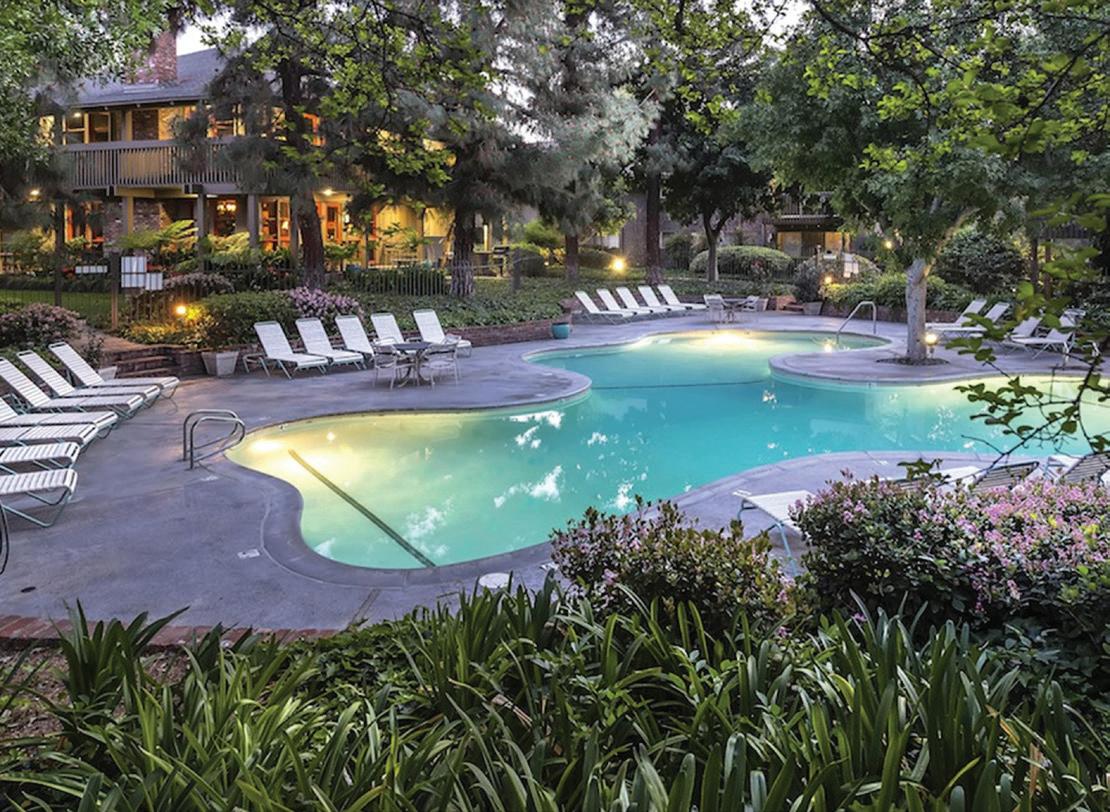
Q: What would you recommend to an average student who may aspire to train like an athlete?
Warren: “I would say the big thing is just remember that it is not all about working out and exercise. You cannot forget about the nutritional aspect because if you are working out and there is nothing in your system, you are only going to hurt yourself.”
Mendez: “To a regular student that would like to train like an athlete I would recommend to find a good workout routine that works for your body and just be as consistent as possible and maintain healthy habits to help you maximize results.”
Ostrander: “Consistency is key. When you can create strong habits day in and day out, you will start to see results and feel like your best self.” San Antonio: “I would recommend to the average student to not be afraid to find time to get active every day. Being active doesn’t mean killing our bodies every time we work out but allowing our bodies to move and flow in the ways we’re naturally supposed to.”
tively at away games.
“As the home team, playing in front of your own fans is the best feeling and it helps elevate everyone’s focus and performance,” Ostrander said. “On the flip side, as the away team it can be uncomfortable for people when they show up to a hostile environment with rowdy opposing fans.”
However, Ostrander said athletes can approach this negative energy with the proper mindset to excel.
“You have to find the fun in it,” Ostrander said. “Even
though it’s odd to hear discouraging things being said to you from the stands, it brings a certain satisfaction when you can find a way to hush the opposing crowd with a big road win.”
CBU fans can contribute to the teams’ success by showing up and creating that supportive, electric environment.

“The fans need to understand the power they have in providing CBU athletics,” Garrett said. “Just that one little push, that one little nudge — psychologically, it does give power to the athlete.”
 Josselyn Guillen | Banner
CBU sports fans cheer for waterpolo athletes.
Josselyn Guillen | Banner
CBU sports fans cheer for waterpolo athletes.
9 September 30, 2022 · Volume 70 · Issue 2 SPORTS
RIVERSIDE APARTMENT HOMES COMMUNITY Leasing Office: 951-688-6101 7955 Magnolia Ave., Riverside, CA Minutes Away from Downtown Riverside • Large Individual Balconies or Patios • Private Yards in Selected Homes • Expansive Windows • Central Air & Heat • Generous Bedrooms, Closets & Bathrooms • Gas Cooking / Microwave • Cable TV Ready • High Speed Internet Available • Just Blocks Away from CBU • Private Gated Community • Large Award Winning Pool & Spa • Elegant Clubhouse with Free Wi-Fi • Billiards • Fitness Center & Saunas • Modern 24 Hour Laundry Facilities • Spacious Grounds & Ample Parking • Stunning Lake & Bird Aviary • Meandering Streams & Walkways • Award Winning Gardens • Community Barbeques
BUSINESS & TECH
CBU’s ITS team working to ght against phishing scam
BY JASMINE SEVERI B&T EDITOR
Early September, California Baptist University’s Information Technology Services Department sent an email out to CBU students informing them that they are working on dealing with phishing scams that have compromised several LancerNet accounts. As October is Cybersecurity Awareness month, students should be ever-vigilant.
Phishing emails are emails attempting to get personal information including passwords and financial information from users for malicious purposes. A spoof is an email that attempts to disguise itself as someone the user knows, such as a friend or a worker, but is actually from an outside source trying to get personal information or trick people into clicking links that will install malware onto their computer.
Dale Lee, CBU’s director of information and security projects, described phishing scams.
“Phishing emails are intended to deceive recipients into thinking they are interacting with someone who is not who they claim to be,” Lee said. “Many phishing emails are malicious with the goal of tricking people into divulging their account passwords or financial account numbers, or in the case of a ‘part-time job,’ scam people out of money.”
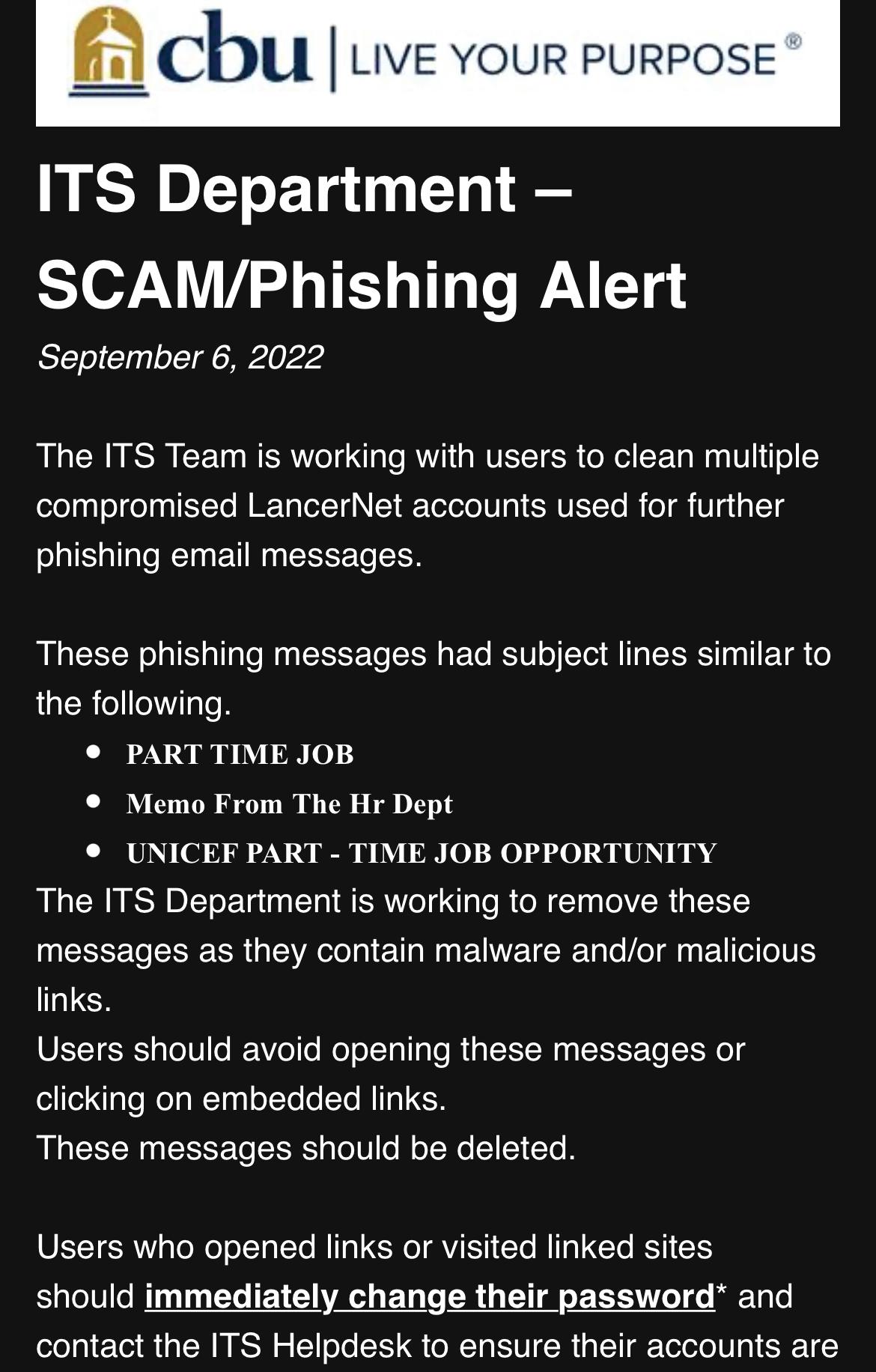
The phishing emails can look legitimate and sometimes
when you call to talk with a person, they may sound legitimate but in the end, their victims ultimately lose.
“The ITS team is working with users to clean multiple compromised LancerNet accounts used for further phishing email messages,” the ITS team said in their email.
“These phishing messages had subject lines similar to the following:
‘PART TIME JOB – Memo From The Hr Dept – UNICEF
PART – TIME JOB OPPORTUNITY.’
The ITS Department is working to remove these messages as they contain malware and/or malicious links.”
Adam Martinez, freshman aviation major, advises students to be cautious about what emails they open.
“If you see a random email pop up and you’re not sure what it is, just, don’t even click on it,” Martinez said. “Just put it in your trash.”
Emily Brault, junior biochemistry and molecular biology major, said she avoids suspicious links and pop-ups and makes sure to have antivirus software on her computer.
“On my computer, I have an antivirus software, so that’s one thing I do to protect my computer,” Brault said. “I also don’t click links in my emails (from
sources I don’t know) and I unsubscribe from a lot of newsletters if I’m getting too many emails from them.”
The ITS team advises CBU students to avoid opening these emails and to delete them.
“Users who opened links or visited linked sites should immediately change their password by logging into Microsoft 365, navigating to https:// myaccount. microsoft.com, and selecting the Password Tile, and to contact the ITS Helpdesk to ensure their accounts are not compromised,” the ITS team said in their email.
Lee advises students to follow a saying used in the cybersecurity industry.
“The cybersecurity industry likes to remind people to ‘Stop, Look and Think’ before taking action on a message,” Lee said. “Don’t click any embedded links or attachments unless you expect them — if not, attempt to validate the email. If a suspicious email claims to be from Wells Fargo to notify you that you had an expected withdrawal, call Wells Fargo or log into Wells Fargo separately to confirm — do not log into Wells Fargo using any links provided in the suspicious email.”
Thirdhand smoke is more dangerous than originally thought
BY KRISTIE WISEMAN ASST. B&T EDITOR
You have likely heard of first and secondhand smoke, but have you heard of thirdhand smoke? Thirdhand smoke has recently emerged as possessing similar health concerns.
Firsthand smoke is the direct inhalation of tobacco products, while secondhand smoke comes from the burning of tobacco products as well as the air exhaled by smokers. Studies have pointed to health risks associated with firsthand and secondhand smoke including cancer, heart attacks, stroke, COPD
and many more.
Dr. Janet Bonome, associate professor of public health, said thirdhand smoke consists of residual nicotine and other toxic chemicals left by tobacco smoke that has settled on indoor surfaces.
“You can think of it as the leftover pollution after a tobacco or e-cigarette is put out,” Bonome said. “It clings to hair, clothes, furniture, carpet, walls, bedding, even dust long after smoking has stopped.”
The chemicals left behind by smoke are nearly impossible to remove and can remain on these surfaces for months.
Due to the focus on reducing first and secondhand smoke, thirdhand smoke has gone largely overlooked. However, recent studies have begun to show that thirdhand smoke may pose greater risks than originally thought.
Thirdhand poses unique dangers as we can be exposed to the same toxic chemicals simply by touching contaminated surfaces. Babies and pets are particularly susceptible to this type of exposure. Babies are constantly crawling around, playing on floors and sticking things in their mouths. This increased risk along with their immature
immune systems place children in danger of developing complications from this smoke, and the presence of thirdhand smoke can double the chances of our pets developing cancer.
Ongoing research is still determining the long-term health risks associated with thirdhand smoke. However, in an article published by Banner Health, Dr. Billie Bixby, a pulmonary specialist at Banner University Medical Center Tucson, said long-term exposure to thirdhand smoke may be comparable to the risks associated with secondhand smoke. Exposure to thirdhand smoke has already
been linked to the development of lung cancer and asthma.
“As we all know, smoking can cause lung cancer which kills thousands of people each year,” said Brittney Helget, senior biology major. “But thirdhand smoking seems to be just as dangerous. Given that less people are educated on its effects, the statistical risks could potentially be greater than we currently know.”
Studies have shown that adequate ventilation and cleaning do not eliminate the hazards of indoor smoking. Since the damage caused by thirdhand smoke is irreversible, prevention be-
comes our first line of defense.
“Prevention can completely reduce thirdhand smoke altogether because if people don’t smoke then it won’t be in the air or in the elements around us,” said Haley Chamber, senior nursing major.
Precautions should be taken to limit the amount of thirdhand smoke in your home.
“Don’t allow anyone to smoke or vape anywhere in or near your home, especially if you have children, or are near pregnant women or have pets,” Bonome said. “It’s really time to get serious about supporting tobacco-free environments.”
Eye-tracking technology allows video games to be hands-free
BY JASMINE SEVERI B&T EDITOR
Over the summer in Washington D.C., I went to an exhibit in the Smithsonian’s Arts and Industries building called Futures. It had many interesting displays of innovations from the past and present and discussions of future technology being developed. But the one that caught my eye that seemed immediately feasible was one that lets users play video games, like Minecraft, with their eyes.
When I got to play it, it had a bit of a learning curve but it always takes some adjustment when learning new controls, and I was pleased, as someone who wears glasses, that I could still interact with it well and did not have any trouble tracking my eyes.
The main thing that took some getting used to was that reading the instructions on the screen made the cursor go where my eyes were reading.
The Futures exhibit at the Arts and Industries building displayed a variety of future technology, from eco-friend-
ly building bricks made out of mushrooms to a possible future sustainable city called Oceanix that floats on the ocean.
“On view until July 6, 2022, Futures is your guide to a vast array of interactives, artworks, technologies and ideas that are glimpses into humanity’s next chapter” the Smithsonian said in a press release on the exhibit.
Besides the wow-factor of being able to control a video game with your eyes, an important way this technology could be implemented is by making video games more accessible to people with problems with their motor skills, arthritis, paralysis, or broken or injured hands who cannot use the typical controllers, whether temporarily or permanently.
Joshua Ramirez, senior biomedical science major, said he is concerned about this technology’s e ect on users’ eyes.
“It seems very taxing on your eyes visually, but I think it’d be cool if they incorporated the eye technology with VR,” Ramirez said.
Alan Landa, junior electrical and computer engineering
major, said it would open up opportunities for people.
“It opens it up for people who really have trouble with manual dexterity,” Landa said. “It’s one of those things that’s very cool that technology is getting that far. I can also appreciate it from an engineering standpoint.”
For the Minecraft game, the setup was simple. Looking around the screen would move the screen in the direction the user was looking, requiring the user only to move their eyes, not any other part of their body. To click on something, the user would stare at the spot for several seconds, and there would be a loading circle showing them how long they need to keep their gaze there.
The first time I tried it, I was slow at it, but the second and third times I tried it, I got faster and could see how this could become as second nature as any other kind of controller. This technology is already available in the United Kingdom and will likely grow in popularity. This might be the future of video game technology.
Charissa Graves | Banner
Dale Lee, CBU’s director of information and security projects, sent a warning email to students Sept. 6.
Emily McGinn | Banner
“ The cybersecurity industry like to remind people to ‘Stop, Look and Think’ before taking action on a message.
Dale Lee director of information and security projects
10 September 30, 2022 · Volume 70 · Issue 2
SAFETY TIPS CPR Check for responsiveness, pulse and breathing. Call 911. according to Red Cross 1 Place the person on their back on a hard surface.2 Give 30 chest compressions. Two hands centered on the chest, shoulders directly over hands, elbows locked at a rate of 100-120 compressions per minute (beat of Stayin’ Alive) Go at least two inches deep. 3 4 5 Give two breaths. Tilt their head back and their chin up to open their airway. Pinch their nose closed. Ensure that each breath makes their chest rise. Continue giving 30 compressions followed by two breaths.
BUSINESS & TECH
Computers controlled by human minds are now in development
BY KRISTIE WISEMAN ASST. B&T EDITOR
Imagine a world where you can control your environment using only your mind. This dream is slowly becoming a reality with the development of Brain-Computer Interface (BCI) technology.
Dr. John Butler, professor of electrical and computer engineering, said BCIs are able to analyze electrical signals from the brain and relay them to output devices that carry out the desired action. This could look like writing on a computer, controlling bionic limbs or wheelchairs and even flying drones This allows BCIs to restore function to those disabled from disorders like Lou Gehrig’s disease (ALS) as well as spinal cord injuries, stroke, cerebral palsy and others.
“Applications would be huge,” Butler said. “Of course, people with disabilities (and) quadriplegic people who can’t move to control things would be a big one, and eventually going into video games and completely immersive VR tech where you can control it all with your mind.”
An example of this is a man named Dennis DeGray. After snapping his neck between the second and third vertebrae, DeGray became paralyzed from the collarbones down. After being approached by Jaimie Henderson, professor of neurosurgery at Stanford University, DeGray agreed to participate in a BCI study.
Henderson implanted a small BCI in the form of a microchip into DeGray’s motor cortex, a brain region associated with voluntary movement.
After more than 1,800 hours of practice and 400 training sessions, DeGray became the world’s fastest mental typist.
By visualizing himself writing words as if with a pen and paper, DeGray was able to mentally write thousands of words with his mind, reaching a record of 18 words per minute.
BCI technology has also allowed DeGray to play video games, manipulate robotic limbs, send texts and email, and even fly a drone using only his mind.
This is just one example of BCI. In 2016, Nathan Copeland, who had been paralyzed by a car accident, was able to fist-bump President Barack Obama with a robotic hand controlled by electrodes in his brain.
In 2021, Pancho, a man who lost his voice due to a stroke, was able to speak again using electrodes placed his brain.
These stories, along with numerous others, display the limitless applications of BCI technology.
However, there is still much to work out before BCIs become standard practice.
“It’s very complicated technology to get brain signals and turn that into something that’s usable,” Butler said.
Several companies have explored devices that do not require implantation in the brain, according to a recent New York
Times article. By using a headset like an electroencephalogram (EEG), there has been some success. However, these devices often sacrifice the power and precision of electrical signals to maintain safety.
Recent advances in BCI technology have aimed to find a less invasive method of implantation. Companies like Neuralink and Synchron are developing a smaller BCI that can be implanted in the brain with only minor surgery.
In 2021, Synchron became the first company to receive approval from the FDA to conduct human trials of a permanently implantable BCI.
Philip O’Keefe was a participant in one such study. Since being diagnosed with Lou Gehrig’s disease, O’Keefe has struggled with mobility and communication. A few months into the trial, O’Keefe became the first person in the world to post on Twitter with a BCI.
“No need for keystrokes or voices,” O’Keefe tweeted. “I created this tweet just by thinking it.”
This is just the tip of the iceberg. More and more research is being poured into the field of BCI.
“This technology is important because it will help us to automate complicated, potentially risky processes in several industries,” said Josiah Norrie, senior mechanical engineering major. “BCIs could be the miracle many people with disabilities have been waiting for their whole life.”
SUSTAINABLE PRODUCT

LEVI’S SECONDHAND
Levi’s offers secondhand clothing, which entails recycling used Levi’s clothing and selling it for a discounted price. Recycling and reusing clothing mitigates wasteful fashion habits, saves resources and lessens waste.
Where to buy:
https://www.secondhand.levi.com with Resale Levi’s Jeans as low as
How does this help the environment? $25
Science and religion are not contradictory to each other
BY JASMINE SEVERI B&T EDITOR
Throughout the century, the archetypes of “the man of science” and “the man of faith” have been pitted against each other: the believer versus the skeptic. While there are certainly believers and scientists who are at odds with each other, this has not always been the case. Throughout most of history and still today, facts and faith go hand-in-hand.
The separation of science and faith is new. While scientific discoveries have caused disagreements within the church and between religious o cials and scientists. like Galileo’s conflict with the church at the discovery that the earth revolved around the sun, this was an internal disagreement among people of the same faith, disagreeing on how to interpret available information, not two opposing forces divorced from each other.
As a Christian institution, California Baptist University integrates the practices of science and faith, and teachers are encouraged to talk about how science relates to Christianity.
Dr. James Buchholz, professor of mathematics and physics, said he does not believe in “the conflict model.” Instead, he said he believes in the “dialogue model.” The conflict model says science and faith are at odds with each other and that they contradict each other. The dialogue model, however, suggests the two should work together.
Buchholz said that he always saw science and religion in harmony with each other and that science was another way to learn about God’s creation and, by extension, God himself. It was not until he went to graduate school that he was confronted with people who could not understand this way of thinking.
“It took me forever to fig-
ure out these two guys in grad school that constantly attacked me had assumed I was a ‘gap theorist,’ which I learned later meant that I believe the gap theory — the theory that the only need for a God is to fill in the gaps that science doesn’t explain, and I never thought that way my entire life,” Buchholz said.
Sophia Neagu, sophomore biology major, said her CBU science teachers make a point to incorporate faith into their teachings.
“Dr. Bonjun Koo has been really good with just incorporating faith into everything,” Neagu said. “Praying and setting aside time to just reflect on how God created a cell and how that is tied to us, or I remember he said something about how some people can’t use the restroom on their own, they can’t eat on their own and how God has gifted us the grace to be able to (help them with) that and how lucky we are as people to do that.”
Neagu said she thinks the world’s outlook on science and religion in our culture has changed vastly.
“I think that ties into the worldview,” Neagu said. “Our world today has evolved into something completely di erent than that, moral-wise. It’s freeing but at the same time, not really, because everyone says, ‘Oh if you don’t agree with this particular kind of thinking, then you’re not right.’ I think that it’s definitely changed and gone a little overboard.”
Chris Colmer, sophomore political science major, said he thinks science and religion can go together.
“Historically, up until very recently, most prominent scientists did believe in God, and they viewed science as a way to prove the existence of God,” Colmer said. “Isaac Newton, famously, was a Christian. So I would say that I reject the notion
that religion and science are incompatible.”
Colmer also said many concepts that people often say contradict what the Bible says do not contradict it as much as they believe if they looked into it deeper.
“A lot of Christians have made the point that the Bible’s creation account doesn’t necessarily contradict astrophysicists’ theories about the creation of the universe,” Colmer said. “A big bang exploding from a singularity could have easily produced a great amount of light.”
Buchholz said that for his 25th teaching anniversary, he received a framed portion of the Bible that contains Romans 1:20, and it is hanging on the wall of his o ce. The passage talks about how God is evident in his creation.
Romans 1:20 reads, “For since the creation of the world God’s invisible qualities — his eternal power and divine nature — have been clearly seen, being understood from what has been made, so that people are without excuse.”
Buchholz said that Galileo took Romans 1:20 seriously and incorporated it into how he approached science.
“Galileo took this Romans 1:20 and he said, ‘Look there’s the two-book worldview. God wrote Scripture, but also God wrote nature. And so there’s two books there, and you should read them both,’ and he said there has to be some coherence between these two because they were made by the same author.”
Buchholz said that although humans wrote the Bible, they were inspired by God. And just as religious scholars could misinterpret the Scriptures, so can scientists misinterpret scientific evidence. Humanity is fallible, but ultimately science and faith should complement each other.
Emily McGinn | Banner
Emily McGinn | Banner
11
APP OF THE ISSUE ALLTRAILS KEY FEATURES WHY I LIKE IT a social app for people leading an outdoor lifestyle Search for hiking trails and find information, ratings and things you should know about a trail as well as reviews about the trail from other members of the AllTrails community. Look up the location of trails so you can use GPS to navigate to trailheads. Connect with other members of the AllTrails community to see what hikes they are doing. You can also post about your own activity. Save favorite trails so you can revisit them. This app excels in the sheer breadth of content it offers. I have been able to find every trail I am interested in trying. I also love the reviews from other users as they often provide useful information such as permit requirements and weather conditions.
September 30, 2022 · Volume 70 · Issue 2
Live Action
Continued from Page 1
live-action Disney movie, and music has always been a big part of the movies. This musical component will likely be an important aspect of “The Little Mermaid,” as per usual.
“I think the favorite that I look forward to is ‘Poor Unfortunate Souls,’” Hansma said. “It was just such a fun song to sing, so I am excited to see their take on that song.”

The most challenging part of each remake is keeping the integrity of the original film.
Because the audience for which the films were initially made has grown up, many fans look for nostalgia when watching these films. Therefore, there is always debate around whether or not the live-action remakes
“The primary focus is nancial, and the studio is hoping to exploit the nostalgia for the build-in audience.
Michael Eaton, professor of film studies and film production
ARTS & ENTERTAINMENT
will give the same feeling the original film would.
Will the live-action version of the “Little Mermaid” have the same e ect that the original movie had back then?
Many live-action films that have been readapted from classic animated Disney films say otherwise. The live-action of “Aladdin” clocked in at 57% on Rotten Tomatoes — a site where movies are rated on if they’re “rotten” or “fresh” — because critics felt the film had many missed opportunities and had unfulfilled potential.
“Beauty and the Beast” with Emma Watson came in slightly higher with a 71% rating, as critics expected more than just nostalgia to make this movie great.
Michael Eaton, professor of film studies and film production, explains his theory that the adaptations of classic animated movies into live-action films and how “the primary concern is financial, and the studio is hoping to exploit the nostalgia for the built-in audience.”
The classics are often held dear by those who watch them, and no replacement or remake will ever live up to the potential of the original for some fans.
“It is fun to see how these new directors interpret the movie, but it is getting very repetitive because there have been so many,” Hansma said.
For many, music can either make or break a film. Robert Ollech, sophomore music edu-
“
I think it’s going to be important when they’re synchronizing both old and new music to make it sound like one movie.
Rober Ollech, Sophomore music education major
cation major, shares his point of view on music in film.
“I think music is a great way to unite people,” Ollech said. “But also, if you get it wrong, it can really take a lot of the spirit out of the music, a lot of the emotion.”

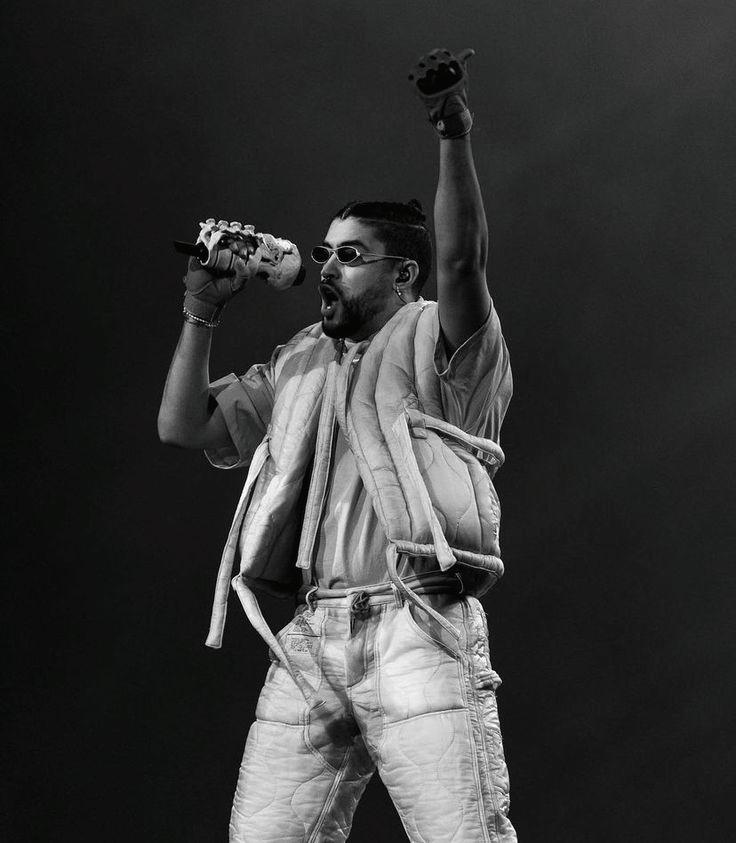




He also said that when Disney releases remakes or sequels, they “need to focus on the quality of the production.”
“I think it’s going to be important when they’re synchronizing both old and new music to make it sound like one movie rather than noticeably old and new music,” Ollech said. “A lot of that has to do with instrumentation in harmony. And then create more of a continuous thread.”
The anticipation for this movie continues to build as Disney reveals more about what is in store for “The Little Mermaid.” Stay tuned for more teasers from Disney.
Fall season showcased in cinematography
BY ZERENITY LOPEZ A&E EDITOR
When someone mentions the fall season, our minds instantly go to pumpkin spice and multicolored leaves. But what about the movies and TV shows that make us think about autumn?
There are obvious things that feel like the autumn season. The familiar feeling of “It’s the Great Pumpkin, Charlie Brown,” Thanksgiving specials for television series favorites or scary movies to run a chill down your spine just in time for Halloween’s spooky season all fall into this category.
That is because those holidays and genres of movies or TV shows can be themed explicitly to a specific season. But there are also subtle aspects of film that make people associate them with the fall aesthetic.
For example, many people associate the television series “Gilmore Girls” with the fall season. The television series follows the lives of a young single mom and her teenage daughter. The show is in a cozy small town with plenty of friendly people, the classic town diner and a loving mother-daughter relationship.
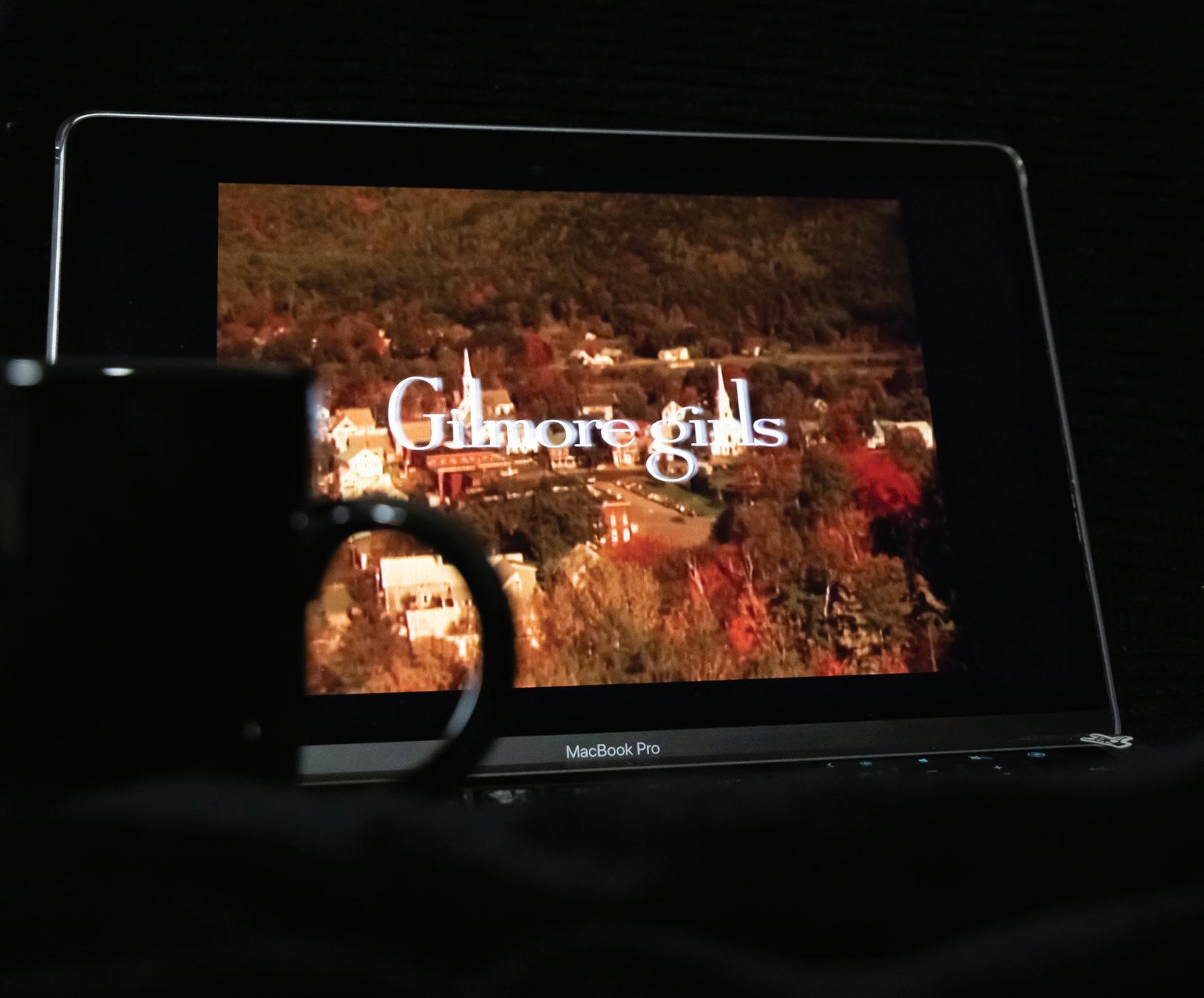

Avery Lang, sophomore
worship arts and ministry major, shares her experience with “Gilmore Girls” and why it reminds her of the fall season.
“There are a lot of things about ‘Gilmore Girls’ that make people associate it with the fall season,” Lang said. “The first thing shown during the theme song is a town surrounded by fall-colored trees, so that puts people in a cozy mood right from the start.”
Micheal Eaton, professor of film studies and film production, provides an inside look at the cinematography that creates a cozy autumnal atmosphere.
Eaton mentions the phrase “Mise en scène,” which Oxford Languages defines as “the arrangement of scenery and stage properties in a play.”
“Mise en scène is a film term that refers to everything placed on the stage or in front of the camera, including the people, that contributes to the visual presentation and overall ‘look’ of the film,” said Professor Eaton.
Everything within the camera’s shot is intentional and contributes to the “feeling” of the production.
Aside from the aspects that make viewers associate content with fall, like a Halloween
episode or a scene at a pumpkin patch, many other factors contribute to the overall “fall feeling” media has.
Simple details like a slight breeze blowing through the protagonist’s hair or warm sunlight peeking through a cloudy afternoon contribute in small ways to trigger the audience’s association with autumn.
“Location, lighting, costumes and sometimes special e ects, such as wind machines or fake snow, can be used to indicate that it is a blustery fall day on a movie set,” said Eaton, whose favorite fall film is “Good Will Hunting.”
Fall is a beloved season to many, especially on a campus like California Baptist University, where so many students cannot wait to beat the heat.
Kaelyn Mondo, sophomore psychology major, shared her favorite television series that puts her in the fall mood.
“‘Virgin River’ is the perfect fall show because of its setting and the vibe of the town where it takes place,” Mondo said. “It instantly transports me to that fall feeling.”
Get ready for this fall season and cozy up to a movie or television series like “Gilmore Girls,” “Virgin River” or “Good Will Hunting.”
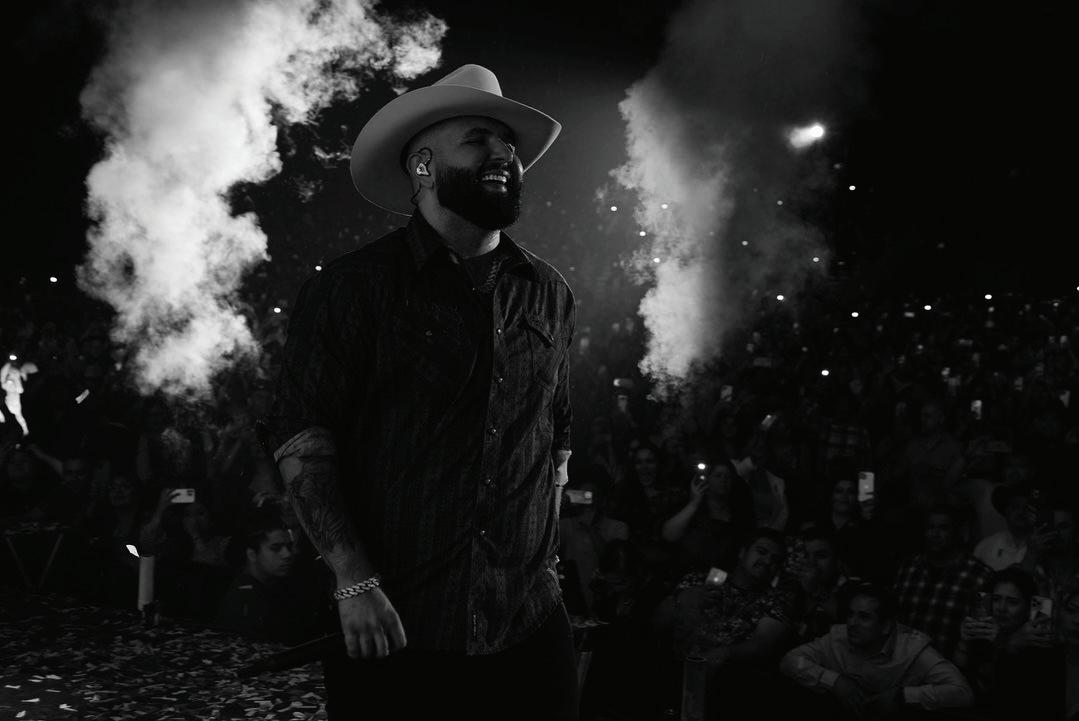 Dominguez |
Photo Illlustration by Charissa Graves | Banner
“Gilmore Girls” is a show that many viewers strongly associate with the autumn season.
Dominguez |
Photo Illlustration by Charissa Graves | Banner
“Gilmore Girls” is a show that many viewers strongly associate with the autumn season.
12 September 30, 2022· Volume 70 · Issue 2
Find in playlist Filters pumpkin spice and everything nice zerenity lopez 1. Gilmore Girls 2. Stranger Things 3. Vampire Diaries 4. Friends 5. Pretty Little Liars 6. Smallville 7. One Tree Hill 8. American Horror Story 9. Gossip Girl 10. Charmed Zerenity Lopez | Banner neverita Bad bunny El amor no fue pa’ mi Grupo firme en el olvido omar apollo Tu ingratitud Carin leon fotos y recuerdos Selena tÚ de qué vas franco de vita tu con el frankie ruiz oye mi amor maná esperame en el cielo los panchos Provenza karol g te pongo mal kali uchis & jowell & randy tu carcel los bukis hasta la raiz natalia lafourcade mi tierra gloria estefan hp maluma la canción j balvin& bad bunny lo que pasó, pasó daddy yankee candy plan b quien como tÚ ana gabriel ciega, sordomuda shakira corazÓn partí0 aleandro sanz tití me preguntó bad bunny eres tu carla morrison lento julieta venegas over the moon the marias solo me dejaste grupo marca registrada el rey vicente fernández aguanile willie colÓn & héctor lavoe prometiste pepe aguilar tu maye tu falta de querer mon laferte pepas farruko querida juan gabriel Playlist Ignacio dominguez
Ignacio
Banner
Award shows decline in views due to focus on marketing value
BY ALEXZA BAHNMILLER MANAGING EDITOR
Award shows in the film industry have been around since 1954 – the year of the first Academy Awards. Back then, the show lasted only 15 minutes and had a live audience of 270 people, according to History.com. In contrast, this year’s Academy Awards lasted three hours and 40 minutes and had a live audience of about 3,300 guests.
The Academy Awards is not the only awards show to increase greatly in production value throughout the years, as today the Golden Globes and the Emmys follow closely behind with similar runtimes and audience sizes. However, this growth in production value does not equate to a growth in viewership. Statistics show that on the other side of the camera, there is actually a decrease in the amount of attention these ‘bigger and better’ shows are getting.
For example, records from Statista.com indicate the Academy Awards lost 20 million viewers between 2019 and 2021, dropping from 30 million views to 10 million. The Golden Globes dropped from 19 million views to five million views between 2019 and 2021 as well, and the Emmys witnessed viewership drop by 25% within the past year, according to Variety.com.
If award shows are increasing in entertainment and marketing value by being longer and larger, where is the audience going?
Gary Zelasko, professor of film studies, believes that the focus on these values might just be the reason viewers are walking away.
“Award shows (in the past) were used to honor people’s excellence in their area of expertise,” Zelasko said. “But now, they are mainly focused around marketing campaigns, and the awards themselves are marketing tools. Ads for the
Olivia Hagen, Freshman film major
award shows attract audiences to both the show and the nominees’ projects.”
Zelasko argues that the entire purpose of award shows has switched from recognizing and rewarding artists’ hard work to just serving as a strategy for people to market their film projects to the audiences who tune in.
“Although the shows used to be merit- and honor-based, they are now commercialized and the winners are those that could a ord better marketing,” Zelasko said.
Controversy around the claim that winners of the awards are bought and not fairly nominated has been swirling for a while.
In a Vanity Fair article, TVGuide data showed that “the average spent on an Emmy campaign for a TV series ranges from $150,000 to $500,000.”
Additionally, Variety magazine estimated in 2019 that “Oscar campaign budgets for films can run from $20 million to $30 million as companies compete with each other to out-wine and dine awards voters.” According to the same article, “The campaign for ‘A Star Is Born’ came in at slightly lower than $20 million, in a studio e ort to spend more strategically than in past years (as with the $25 million it spent on ‘Argo,’ or the $20 million for
‘Gravity’).”
Olivia Hagen, freshman film major, believes that the award shows have been corrupted.
“Award shows nowadays give out awards based on popularity, but they should be chosen by film critics who critique the artistic value of the films,” Hagen said.
Yselle Barajas, sophomore psychology major, noted that she does not tune in.
“I don’t watch them,” Barajas said. “I don’t think people really care about who wins the awards anymore. The only times I really hear about the shows are when people are talking about the red carpet outfits. People who still watch for the awards are probably just doing it out of nostalgia.”
Though the change in the focus of award shows has shifted, Zelasko encourages students to still seek out quality films independently, regardless of the amount of marketing or awards the film may have received.
“There is always an audience for good films, whether or not it is recognized with awards,” Zelasko said. “People will support films with great values and quality production that tell a story well.”
A day in the life of an art therapy major
Mikayla Morehead, senior art therapy major
7 a.m. – Wake up and go to the gym
9 a.m. – Depending on the day, meet for coffee with a student as their First-Year Experience leader, or coffee with a friend
10:30 a.m. – 12 p.m. – Head to my first class, Folklore and Fairytales
11 a.m. – Eat lunch at either Chick-fil-A or El Monte
12 – 2 p.m. – Break, where I do homework, including several painting assignments like still life, abstract and self-portraits. My homework also includes reading for my classes, doing art projects, planning art prompts and even writing essays. During my break, I meet up with friends at Wanda’s too.
2 – 5 p.m. – Head to my studio painting class
5:30 p.m. – Meet with the International Justice Mission Club
6:30 p.m. – Eat at either Chick-fil-A or El Monte
7 p.m. – Attend my church home group
Gary Zelasko, Professor of film studies
11:30 p.m. – Bedtime
EDITOR’S REVIEW
“Don’t Worry Darling”
BY ZERENITY LOPEZ I A&E EDITOR
Don’t Worry Darling has been one of the most anticipated movie releases of the fall season. With its initial announcement for production being released in July of 2019, both Harry Styles and Florence Pugh fans were very excited to see them take on lead roles in the lm.
The lm, directed by Olivia Wilde, who also played a supporting role, ventured to create a psychological thriller that many may call captivating. While the lm was both psychologically inclined and thrilling, I feel that the thrill aspect of the movie relied heavily on the abrupt nature of the soundtrack.
The soundtrack stayed true to the nature of the 1950s housewife appeal but was accompanied by grating female vocals that I assume intended to keep the viewers on edge. If a soundtrack is the main reason the audience is glued to their seat, I believe that says more about the writing than the integrity of the soundtrack.
The movie’s plot had much potential, but the lack of support from the writing did not allow the lm to be translated in the way I believe Olivia Wilde intended. The lm makes a nod to gender roles that were very apparent in the 1950’s. Florence Pugh’s character as well as the rest of the women in the lm play the perfect houswives. Olivia Wilde’s direction makes it a point to highlight that the wives’ sole purpose is to support and care for their husbands.
With the way the writing was done, however, performances from Styles and the supporting characters make it di cult to see the lm’s deeper meaning. In my opinion, the shallow script was not as profound as it could have been. A part of me wishes that the lm would have dived deeper into the psyche of Styles’ character
Now let’s discuss the visuals of the lm.
When it comes to psychological thrillers, visuals are an essential aspect. The lm must make the audience believe that their mind is playing tricks on them.
In “Don’t Worry Darling,” I found the “shocking” visuals somewhat predictable. Throughout the movie, I was already expecting what the next scene would look like. To my dismay, I was right the majority of the time.

The lm also included many cut scenes, which seemed to assist in moving the plot forward. The sheer amount of cut scenes alone made it very confusing at times. One blink, and suddenly, there is a di erent setting, with new characters, and nothing is familiar.
Since the lm’s release, all anyone is talking about is the plot twist toward the movie’s end. I will admit that the curveball took me by complete surprise and, in my opinion, tied the lm together very well. The shock factor was not fantastic enough to save it from poor ratings on Rotten Tomatoes (38%), but it did earn a few brownie points in my book.
3.5 out of 5 stars.
“Award shows nowadays give out awards based on popularity, but they should be chosen by lm critics who critique the artistic value of the lms.
“Award shows (in the past) were used to honor people’s excellence in their area of expertise. But now, they are mainly focused around marketing campaigns.
Emily McGinn | Banner
Photo courtesy of Warner Bros. Studio
13ARTS & ENTERTAINMENT September 30, 2022 · Volume 70 · Issue 2
Student-athletes face work-life balance
BY HANNAH GORDON ASST. SPORTS EDITOR
Between crazy schedules and being in the public eye, student-athletes are in a unique position at California Baptist University.
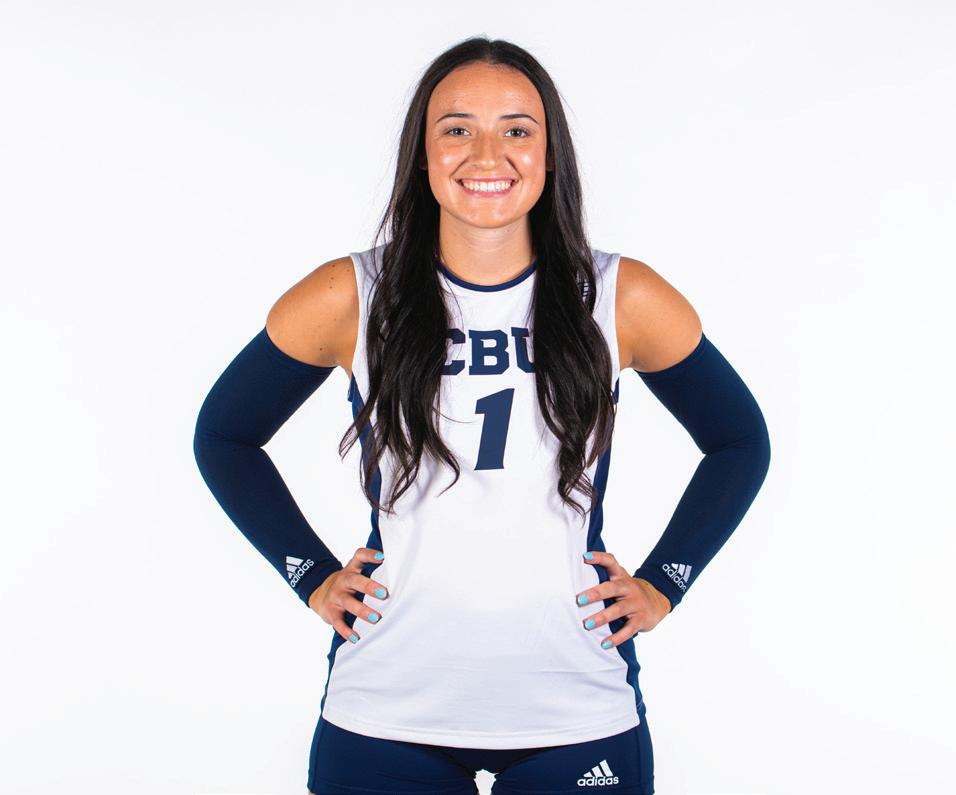
Students who are not also athletes do not have to perform in front of hundreds of people — let alone peers — on a weekly basis. But in the end, student athletes are also students who are trying to pass their classes like everyone else. According to the National Collegiate Athletic Association, student-athletes need to earn a 2.0 cumulative
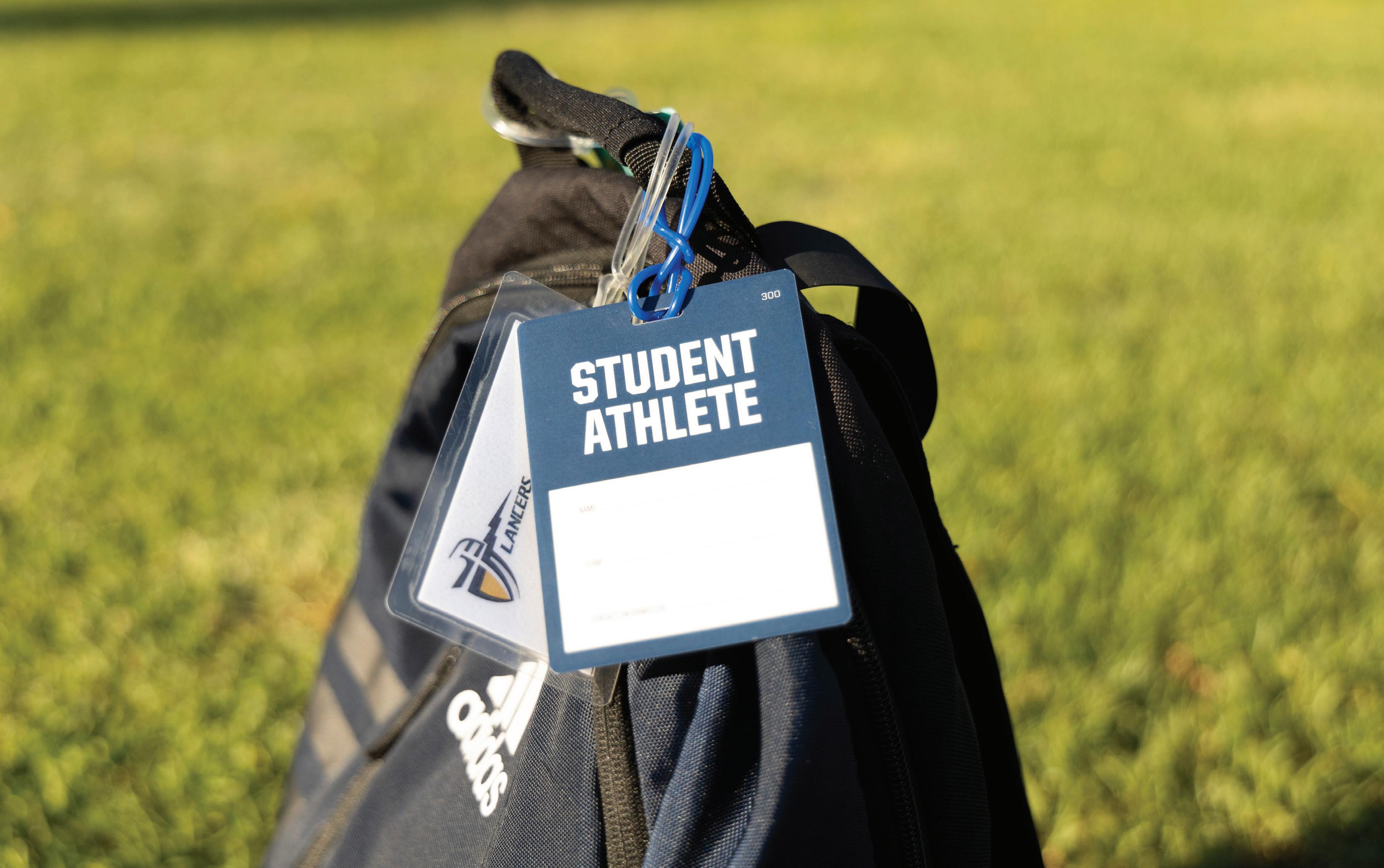
grade-point average every year to continue to play.
“Student-athletes also typically devote more than 40 hours per week to their sport,” reads a study conducted by Eddie Comeaux from the University of California, Riverside. “This creates tremendous demands, expectations and stresses outside of typical college life.
“In the modern era of intercollegiate sports, student-athletes endure the day-to-day demands of practice, extensive travel for competition, midweek games, team meetings, rehabilitation for nagging injuries and mental fatigue. In many
cases, college coaches have near complete power and control over the lives of their athletes, and as a result, student-athletes’ ability to integrate fully into the academic and social systems of college is disrupted, and they may have di culty fulfilling their academic obligations and goals.”
Student-athletes have to balance being 100% athlete and 100% student. This may lead to bad experiences with others who are not understanding and treat athletes according to their own assumptions.
“Division I student-athletes face negative stereotypes about
their characteristics and behaviors,” Comeaux’s study reads. “They are rarely perceived as ‘highly intelligent’ or as deserving other descriptors or related behaviors that suggest they have the capacity to achieve the highest levels of academic success.”
Comeaux uses the term “athlete microaggressions” to describe negative behavior toward student athletes.
On top of negative assumptions and unique schedules, student athletes can struggle socially.
“The biggest assumption people have of me is that I am
LANCER OF THE ISSUE
stuck up, but everyone who has told me that and actually got to know me has said that I am actually a nice person and easygoing,” said Leo Mendez, striker for the men’s soccer team.
He goes on to describe his experience being a student-athlete.
“Some people do treat me di erently for being an athlete,” Mendez said. “I’ve had both good and bad experiences with this, but it just depends on the person. Some are very nice and supportive, and others are rude and envious about certain things.
“I have had a few negative
experiences with both students and professors. In high school, I had a teacher that would tell me that playing soccer was a waste of time and I was not getting anything out of it.”
In the end, student-athletes are just like us. We all prioritize what is most important to us and we commit time to what we love to do.
“My schedule does a ect my social life,” Mendez said. “It’s a sacrifice that comes with being a student-athlete, but I love the sport enough to keep playing even though I don’t have much time to hang out with friends and family.”
NURSING
“I started playing volleyball when I was 11 years old. I was playing softball for most of my life and quickly got bored of it, so my mom got me into volleyball.”
“The coaching staff and the girls really made it feel like home here at CBU when I came on my visit, and I fell in love with the campus and the atmosphere.”
“I would say competing at a high level every day with my team is my favorite part.”
Q: WHAT ARE YOUR GOALS FOR THE SEASON?
“My goal for the season is to win a WAC Championship with my team and to go far in the post-season.”
Q: WHAT HAS BEEN THE HIGHLIGHT OF THE SEASON SO FAR FOR YOU?
“My highlight for the season so far has been beating UC Irvine in ve sets. That was a huge win for us, and getting All-Tournament at the Washington State Tournament at the start of preseason (was a highlight).”
WHAT IS YOUR ROUTINE TO PREPARE FOR GAMES?
“Before every game, I like to go through what I wrote in my journal to help me mentally prepare for the game and I have to take a nap to actually reset.”
Marharyta Smirnova | Banner
Some student-athletes may feel a disconnect between themselves and their academic peers.
DID YOU START PLAYING
LED YOU TO BECOME AN ATHLETE AT CBU?
IS YOUR FAVORITE PART OF
FOR CBU?
Emily McGinn | Banner
14 September 30, 2022 · Volume 70 · Issue 2 SPORTS
LANCER SCORECARD Men’s soccer 4 - 3 - 1 as of Sept. 28 Women’s soccer 5 - 1 - 2 Women’s volleyball 6 - 7 Men’s waterpolo 8 - 6
PAIGE JOHNSTONE, MEMBER OF WOMEN’S VOLLEYBALL AND SENIOR
MAJOR Q: HOW
VOLLEYBALL? Q: WHAT
Q: WHAT
PLAYING
Q:
LANCER ON THE STREET
How do you feel about non-af liated CBU Instagram accounts (i.e. CBU Confessions)?
“It can get a little vulgar sometimes. I’m not on there for that, but it’s fun to grow a community and get to see people that you don’t know.”
“It could be a tool used for bad and it could seem like there’s a lot of hate at the school. But you’ve got to realize that this is just a vocal group.”
Attention voters: please do your research
around every two years and many more state and local matters — from propositions to primaries to gubernatorial elections — sprinkled in between.
Many of us have heard that it is important to vote, but as we cast our votes, do we place the same importance on how we are voting and what we are doing to prep for such a task?
BY EMILY MCGINN EDITOR-IN-CHIEF


Campaign advertisements are making the rounds on television. Political pundits are discussing House races. We will be receiving ballots in our mailboxes in the next few weeks.
The signs are all there: It is election season again.
It seems like we are always casting our ballots for something, with either midterms or presidential elections rolling
In a republic such as the U.S., we have placed our faith in the idea that the people hold the power, meaning we can, as a group, determine the route of our nation. However, the only way to develop a successfully functioning power-to-the-people system is if the members of the electorate make individual e orts to thoroughly understand the foundations of the nation, their rights and the issues at hand.
In a study conducted in 2017 by the University of Pennsylvania’s Annenberg Public Policy Center, surveyors found that many Americans lack a basic
understanding of the structure of the government. 37% of those surveyed could not identify a First Amendment right, and only 26% could identify all three branches of the U.S. government. This lack of a basic understanding of the Constitution highlights a concerning existence of political ignorance in our electorate. How can members of the nation successfully vote for candidates and solutions if they do not have a foundational knowledge of why our country is structured the way it is?
This trend in a lack of knowledge about the origins of our nation presents a concerning precedent for understanding the U.S. in a modern context. If the electorate does not understand the basic aspects of the U.S. government, how can it be expected to make decisions that will impact how it operates and who is operating it?
While I am sure the education system plays a role in this
Course fees should include textbooks
Board? Check. Meal plan? Check. Tuition? Check. You are getting excited. Everything is set, right?
But then you get the email notification. You scroll and you widen your eyes in horror when the title reminds you of something you forgot. The title of the email reads, “TEXTBOOKS NOW AVAILABLE.”
classes. You spent all of that money on your education, and now you are still stuck.
lack of understanding, we also must acknowledge the individual responsibility we all possess to do the necessary research to both understand our nation’s foundational principles and to better understand our nation through the modern scope. This responsibility entails not only figuring out which issues and candidates we will be voting on in November, but also researching policies, the pros and cons of any solution or candidate and how voting for a certain solution or candidate will impact the nation on a larger scale.
Unfortunately, even the process of seeking out political news and researching it can contribute to political ignorance if we do not use the best sources. According to a 2020 Pew Research Center study, 18% of U.S. adults primarily found political news on social media, and 48% of this group were ages 18-29.
While this method of finding political news is a good step-
ping stone, using social media as one’s sole source of gaining political knowledge will not result in an informed electorate.
Rather, as we research political topics, we must be wary of bias and attempt to understand an issue holistically through consulting reliable sites and individuals.
Most importantly, as we consider knowledge that we gain about various political topics, we should use our most powerful tools: our minds. We have the power to think critically about issues and analyze how a political decision or policy might impact not only ourselves, but also others, including those who might be di erent from us. For example, have you lived in the city your whole life? When you encounter an issue about agriculture, do your due diligence and research how a decision might impact a farmer living in another part of your state instead of blindly casting your vote.
The midterms are not a presidential election, so I know they are less exciting. It can be more di cult to see their purpose in the greater fabric of the nation. I also know it can be easier, especially as busy college students living in a politically polarized society, to push politics far out of our minds and exist in our own bubbles. However, I encourage you to embrace politics and do your research because, at the end of the day, most issues — including those you care about — are political in some way. The decisions we make when we vote directly impact us, whether we acknowledge it or not.
So, I encourage you to show up and cast your ballot this election season. But please do not do it unless you are confident in your decisions and have done your due diligence, because your last-minute decision at the ballot box could be impacting someone else’s life. Be aware of your power and wield it wisely.
CBU Confessions should allow for more freedom of opinion
BY ALEXZA BAHNILLER MANAGING EDITOR
Going to college is expensive. Tuition is unfortunately usually only the beginning of the fees. Next comes housing, food and travel (gasoline or bus fares). Then comes supplies. Costs continue to increase if a student needs a laptop, notebooks and, of course, textbooks.
All of these items are necessary, and almost nothing is free.
The total average cost to attend school (combining tuition, housing and food only) per year is $35,551 in the U.S., according to educationdata.org. To break this number down, the average cost per college course is $2,355.
Let’s assume you are a student who decides to take four courses each semester. That results in $18,840 for a year of courses, so about 53% of the money you will be spending all year will go toward course tuition alone.
Let’s skip ahead. You worked out all the logistics. You got the loans you needed, and you worked the extra hours you needed too, and now you can finish paying o the big stu .
You think to yourself, “Maybe there won’t be any required textbooks this year. Maybe I’ll be able to find a PDF copy. Maybe I’ll find it in the library.” You tell yourself anything to convince yourself you are done spending money.
But this is not the case. You see the first required textbook: $120. Luckily, the next class does not require a textbook, but wait — an access code is required: another $97. After adding up the required textbooks, the cart comes out to $374.
Let’s say it’s the worst case scenario: none are available as PDF copies, and the library is out of stock. This $374 will have to come out of your pocket, and according to educationdata.
org, this is about the average students do end up having to spend. A study from educationdata.org showed that students spend, on average, between $628 and $1,471 a year on textbooks.
So you have to buy the textbooks yourself, but the issue is, you just spent all your money.
More importantly, half of that money went to the courses for which you will not be able to a ord the textbooks. And if you cannot a ord the textbooks, you cannot participate in the
A scenario similar to the one described above is common for students attending college. Loans often cover course tuition, housing and just enough for food, but rarely are textbook costs discussed until days before classes begin. This leaves students scrambling to come up with hundreds of dollars to even participate in the classes that they have paid to attend.
Is this fair? In my opinion, no.
Class tuition should cover all course-related costs, including textbooks. If the class is a lab, lab equipment should be included. It should not be assumed that just because a student has enrolled in a class, they have the finances to pay for another $500 in equipment once the class begins.
It should be the responsibility of the school to assess equipment costs and make sure these costs are covered in the course tuition. If this means that the course costs must increase, at least the students will be aware of the true price of the class with all expenses included. With this knowledge, students can figure out ways to finance the class beforehand.
Also, it prevents students who cannot a ord the textbooks from spending their money on courses and then not being able to participate or learn as much as others do.
Every student should have equal opportunity to learn but also to know costs up front, and this will help ensure that.
BY ZERENITY LOPEZ A&E EDITOR
As students at California Baptist University, we are no strangers to the various school-specific Instagram pages that have sprouted and gained the following of CBU students. The most popular of those accounts is @cbu.confessions, clocking in at 4,716 followers.
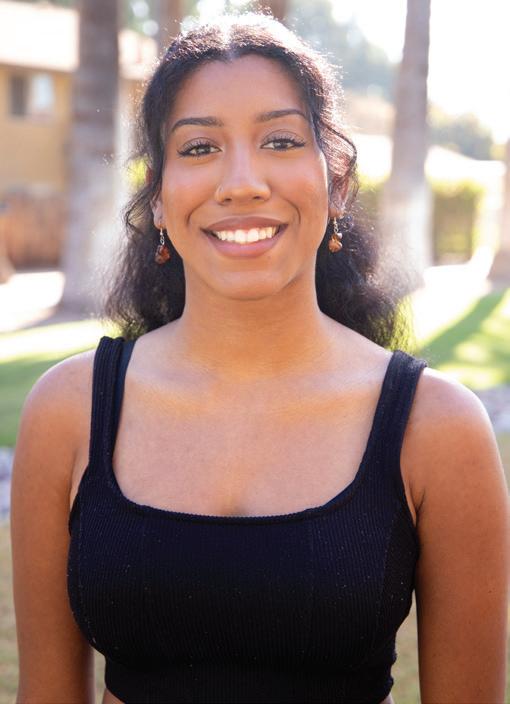
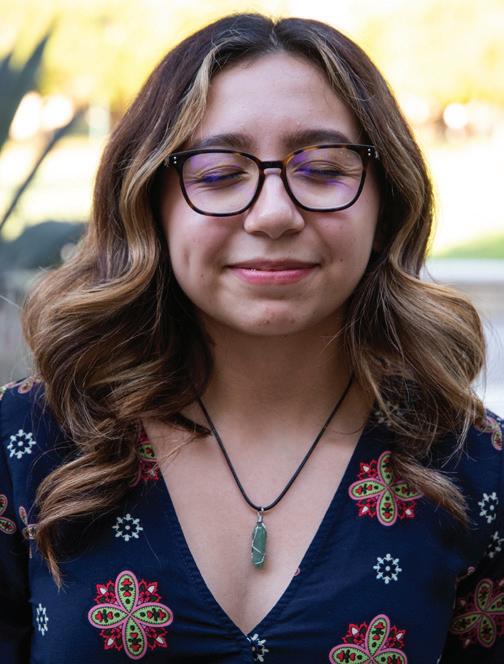
The Instagram account has no a liation with CBU, but it has made its mark.
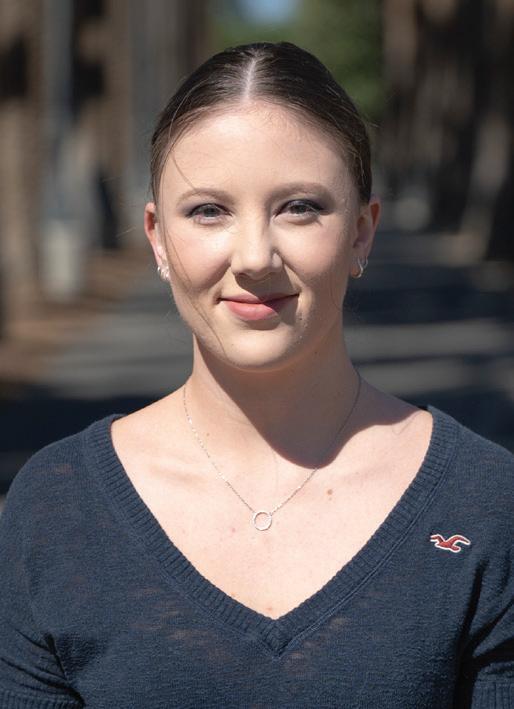


While the page originated intending to be a haven for anonymous “confessions,” it quickly morphed into a hub for quick information on the school and a place for people to promote small businesses, sell books, complain and even share the occasional meme poking fun at fellow students.
With the new school year, there was an announcement of a new administrator now in charge of the beloved @cbu. confessions Instagram ac-
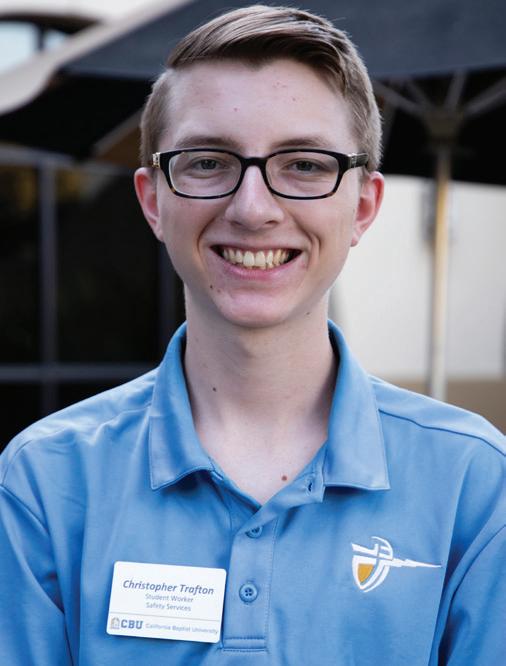
count, and some students can feel the di erence.
The new admin, who remains anonymous, has kept the page’s integrity by promoting school news, memes and student confessions. But they have added more of their opinion to the daily posts. The last administrator made it a point to remain objective, and I think that has emerged as a significant difference between the two.
There have been a few occasions where the admin voices their opinion on what their followers have sent in or commented on their posts.
The most memorable experience in my mind was when there was controversy surrounding a student promoting the Latino Student Union Club. The negative comments about the situation were posted separately on Instagram Stories, and the admin even gave their two cents on the topic.
This can help guard the emotions of students who may feel insulted or o ended by their fellow students. I think removing hateful comments is morally correct, but when it leaks into positions that the admin simply disagrees with, it becomes censorship. I do not appreciate being limited on social media by a sole content creator, especially with a page like @cbu.confessions, which heavily relies on its followers to remain active.
The admin has also asked for feedback from their followers on how they are doing. That strikes me as a bit odd, to be
honest. I understand they want to gauge their success within the account, but I believe success speaks for itself. The constant need for approval is tiring and comes o as insecure. In my opinion, if someone has to ask how they are doing, they probably are not doing that great of a job.
The polls asking whether or not they are doing a good job can come o as the admin being unsure of themselves. When asking for feedback, you should expect it to be honest. The whole point of requesting their follower’s opinions is to find out what they think of the page, right? However, getting defensive about constructive criticism deters followers from wanting to express their opinion in the first place. For example, on Sept. 25, the admin responded to feedback by commenting, “…it’s my account at the end of the day I will do what I want-.” With that mentality, I would not be surprised if the account lost some of its following.
Overall, as a new admin for a well-established social media account, they have kept the page running smoothly by posting stories and regular posts multiple times a day and maintaining its users’ anonymity. But over the last few weeks, they have added their own personal flair to the page. This personal flair of theirs is not for everyone.
Good luck to the new @cbu. confessions admin. It can only go up from here.
Elizabeth Valenzuela Lopez essaly Villanueva Tori Hitchcock
Christopher Trafton Grace Fleming Freshman Junior Sophomore Music major Computer science major eatre majorFilm major
Graphic design major
Sophomore Sophomore
“I believe it’s a great way for people to voice their opinions. It’s a great way to get insight. I feel like they provide good resources that allows di erent perspectives.”
“I think they’re fun. It’s a good way for students to kind of intermingle with each other.”
“I really enjoy them. I think a lot of the discussions and topics on there are really interesting and I like scrolling through them.”
September 30, 2022 · Volume 70 · Issue 2 15
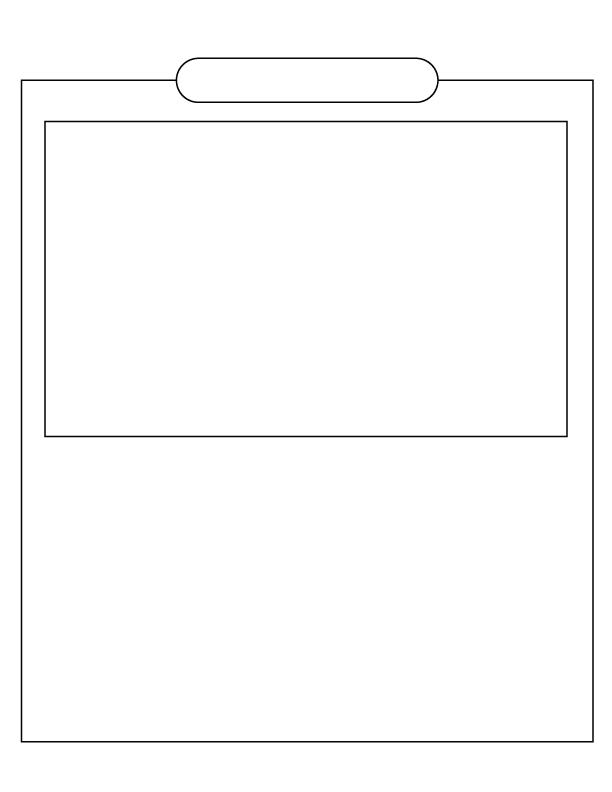



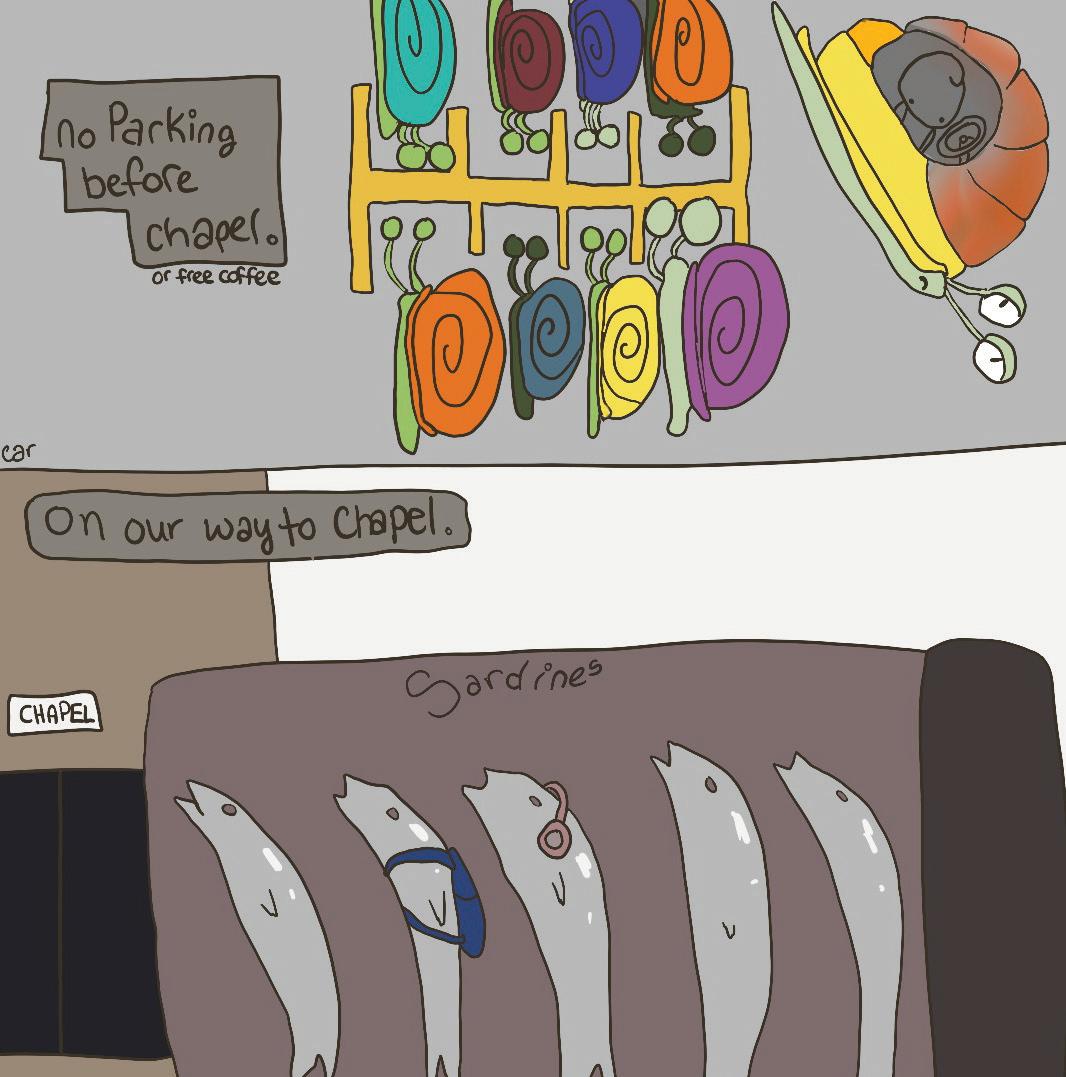
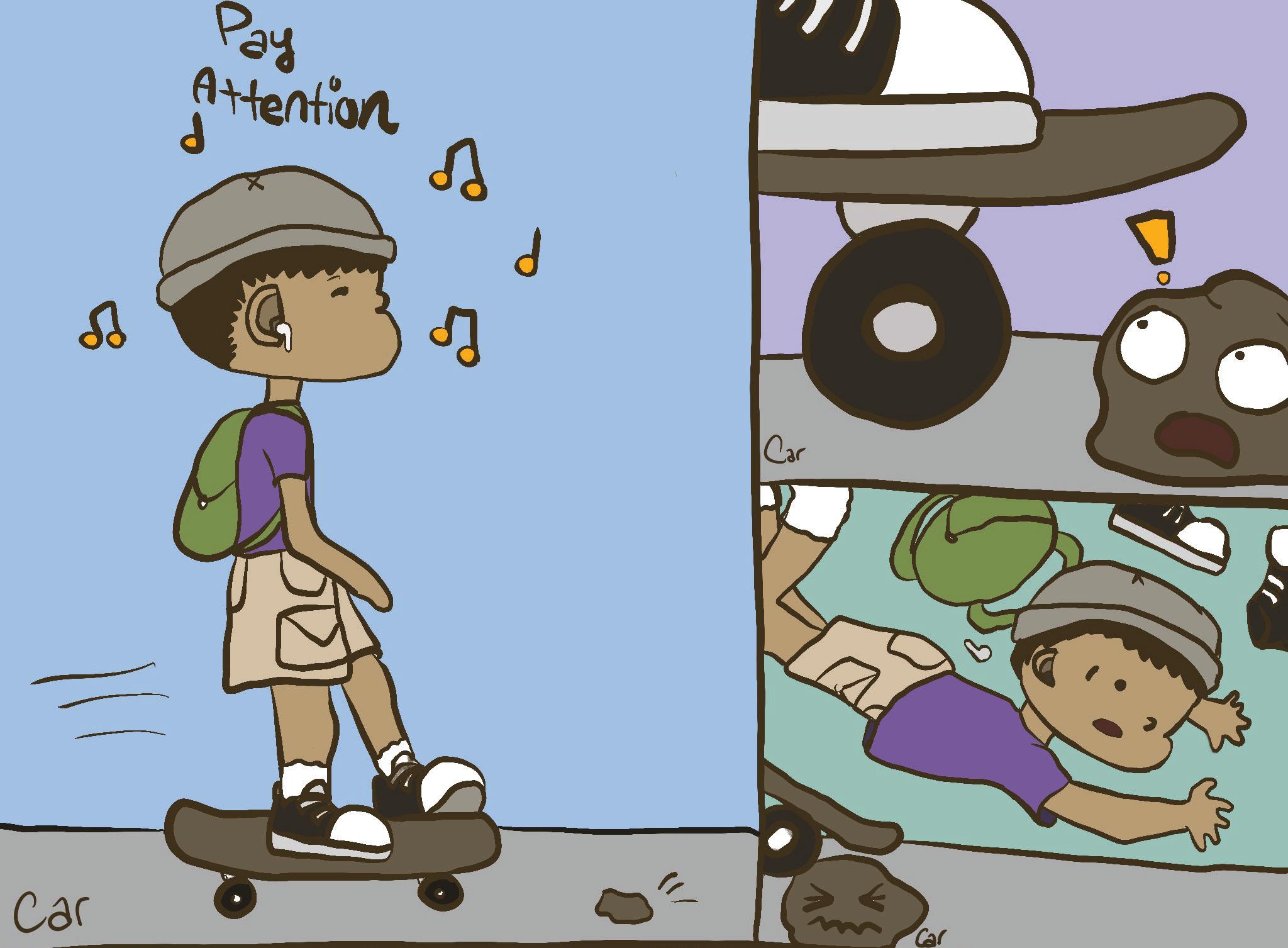
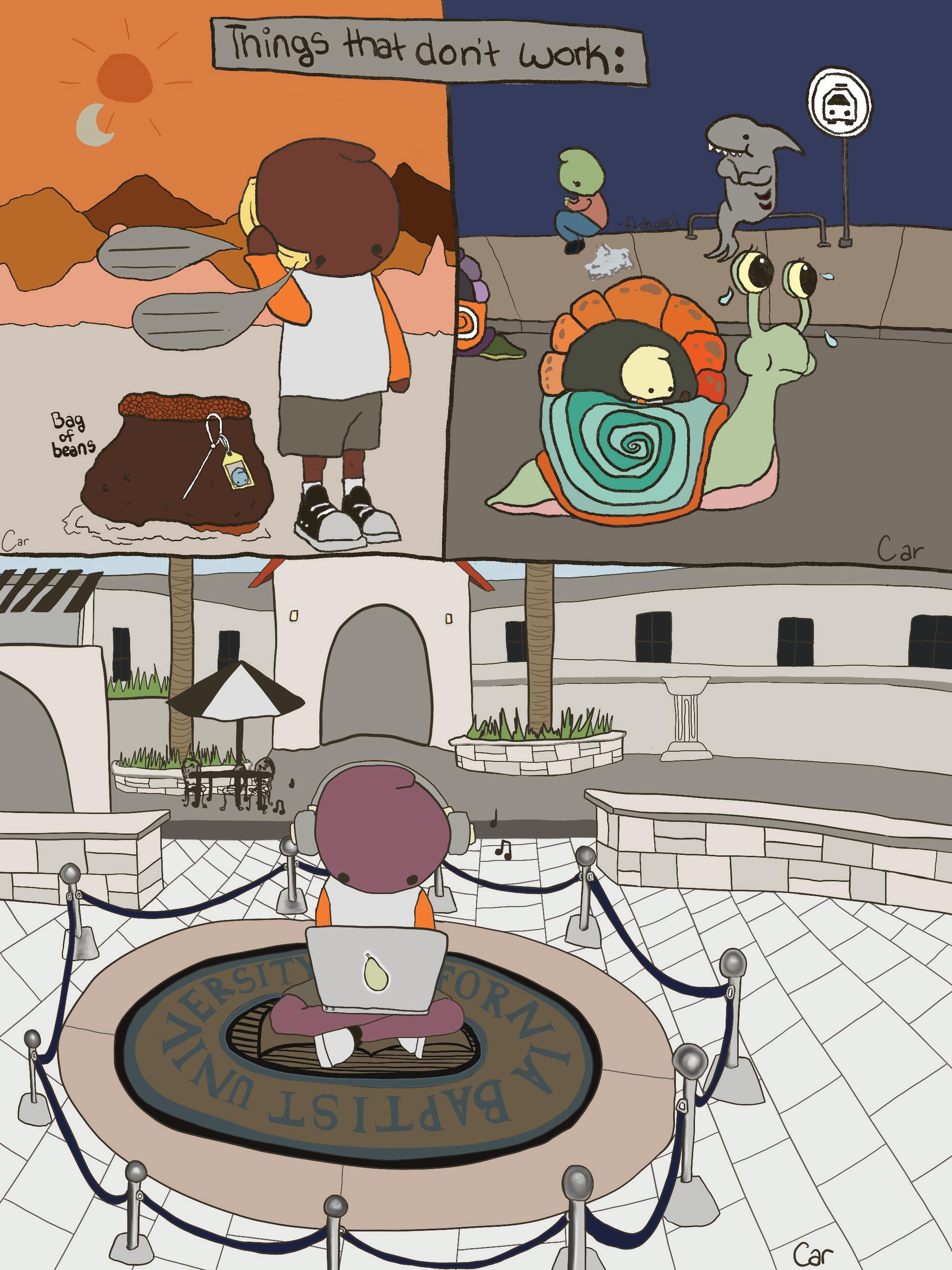
 Cartoons by Carly Brunner
Cartoons by Carly Brunner
Name: _________________________________________________ Healthy Living F P U H A H A X W B J W E C K C Q N V S A L A D E F T U T W N D M H T Y X N Z Z V F Z A B K J Y U U O O B V W Z A T P I R A L P G H T P J C E E A H U Q W H T U C T X F R E J O U G T K Y Y E E M A I H H Y I T G L V E E L Y G V K G B M T D U T R C A P T R E X E R C I S E I H G I T P T U A R Z W W B U Z F N F N V O O W E G B Z G O C M I P T Q C Q S N P W S Z L G I S N L S P R O T E I N E L M J E W R Z K M H G Z M M X I I V R V H G Find the following words in the puzzle. Words are hidden and CHOCOLATE EXERCISE FRUIT HEALTH NUTRITION PROTEIN SALAD VEGETABLE VITAMINS WATER September 30, 2022 · Volume 70 · Issue 2 CHOCOLATE EXERCISE FRUIT HEALTH NUTRITION PROTEIN SALAD VEGETABLE VITAMINS WATER For more information about how to eat healthy on campus, see Vision, pages 4-5. WORD BANK 16 Lanc Life Fun & Games 6 4 8 9 5 7 6 3 1 2 7 5 9 6 2 4 2 1 6 4 7 6 1 2 5 8 9 5 7 3 Puzzle 1 (Medium, difficulty rating 0.47) Generated by http://www.opensky.ca/sudoku on Mon Sep 26 21:06:00 2022 GMT. Enjoy! SUDOKU WORD SEARCH: NUTRITION
